1895 to 1937: Early Nuclear Science
November 8, 1895 German physicist Wilhelm Conrad Röntgen discovers x-rays.
1896 French physicist Henri Becquerel discovers radioactivity.
1898 Marie and Pierre Curie discover polonium and radium.
1911 Ernest Rutherford articulates his model of the atom, at the center of which exists a nucleus containing the majority of the atom’s mass and all of its positive charge.
June 3, 1920 Ernest Rutherford speculates on the possible existence and properties of the neutron in h

December 28, 1931 Irene Joliot-Curie reports studying penetrating particles produced by beryllium when bombarded by alpha rays. She believes the particles, which are actually neutrons, to be energetic gamma rays.
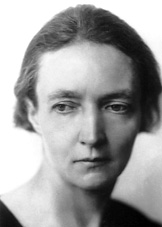
May 1932 British physicist James Chadwick discovers the neutron.
September 12, 1933 Leo Szilard conceives the idea of using a chain reaction of neutron collisions with atomic nuclei to release energy. He also considers the possibility of using this to make bombs. This predates the discovery of fission by more than six years.
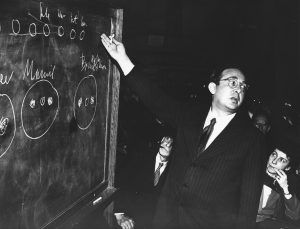
Mid-January, 1934 Irene Joliot-Curie and Frederic Joliot conduct the first demonstration of artificial radioactivity.

May 1934 Enrico Fermi and his team in Rome bombard elements with neutrons and split uranium but do not realize it.

July 4, 1934 Szilard files a patent application describing the use of neutron-induced chain reactions to create explosions and the concept of the critical mass.
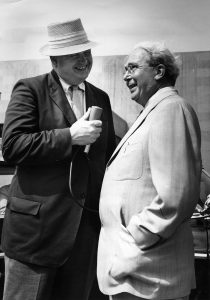
September 1934 Ida Noddack publishes a paper in Zeitshrift fur Angewandte Chemie arguing that the anomalous radioactivities produced by neutron bombardment of uranium may be due to the atom splitting into smaller pieces.
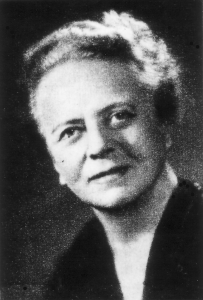
October 22, 1934 Enrico Fermi discovers the principle of neutron moderation, and the enhanced capture of slow neutrons.
October 8, 1935 The British War Office rejects Leo Szilard’s offer to turn over to them his patents of nuclear energy for free, an offer made to bring them under British secrecy laws.
December 1935 James Chadwick wins the Nobel Prize in Physics for discovery of the neutron.

February, 1936 The British Admiralty accepts Leo Szilard’s offer to turn over his patents.
1938 to 1939: Discovering Fission
December 21, 1938 Otto Hahn submits a paper to Naturwissenschaften conclusively showing the production of radioactive barium from neutron irradiated uranium.

December 24, 1938 Otto Frisch and his aunt Lise Meitner correctly interpret Hahn’s results as evidence that the uranium nucleus had split in two (Fission).

January 13, 1939 Otto Frisch observes fission directly by detecting fission fragments in an ionization chamber. With the assistance of William Arnold, he coins the term “fission”.

Mid-January, 1939 Leo Szilard hears about the discovery of fission from Eugene Wigner. He immediately realizes that the fission fragments, due to their lower atomic weights, would have excess neutrons that must be shed.
January 26, 1939 Niels Bohr publicly announces the discovery of fission at an annual theoretical physics conference at George Washington University in Washington, DC.
January 28, 1939 Physicists recreate fission experiment at the Carnegie Atomic Physics Observatory in Washington D.C.
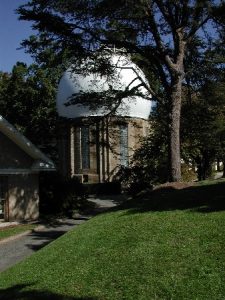
January 29, 1939 J. Robert Oppenheimer hears about the discovery of fission. Within a few minutes, he realizes that excess neutrons must be emitted, and that it might be possible to build a bomb.

February 5, 1939 Niels Bohr realizes that uranium-235 and uranium-238 must have different fission properties, uranium-238 could undergo fission by fast neutrons but not slow ones, and that uranium-235 accounted for observed slow fission in uranium.
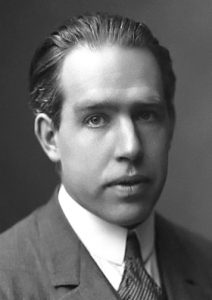
March 1939 Enrico Fermi and Herbert Anderson find that there are about two neutrons produced for every one consumed in fission.
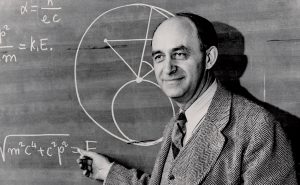
April 22, 1939 Frederic Joliot and his group publish their work on the secondary neutrons released in nuclear fission. This demonstrates that a chain reaction is indeed possible.
June 1939 Enrico Fermi and Leo Szilard submit a paper to Physical Review describing subcritical neutron multiplication in a lattice of uranium oxide in water, but it is clear that natural uranium and water cannot make a self-sustaining reaction.
July 3, 1939 Leo Szilard writes to Fermi describing the idea of using a uranium lattice in carbon (graphite) to create a chain reaction.
August 2, 1939 Pres. Roosevelt receives “The Einstein Letter” warning about the prospect of an atomic bomb.

August 31, 1939 Niels Bohr and John A. Wheeler publish a theoretical analysis of fission. This theory implies that uranium-235 is more fissile than U-238, and that the isotope of the undiscovered element 94 with 239 nucleons is also very fissile. These implications are not immediately recognized.
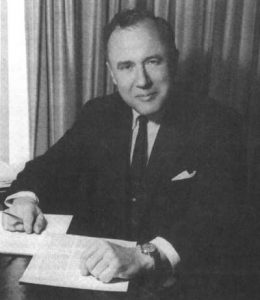
September 1, 1939 Nazi Germany invades Poland, beginning World War II.
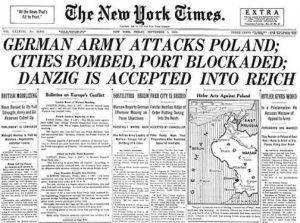
1939 to 1941: Investigating Nuclear Weapons
October 21, 1939 The first meeting of the Advisory Committee on Uranium in Washington, DC, which was created at President Roosevelt’s order. The physicists argue for urgent government attention, but Adamson is hostile. Teller requests $6,000 for research on preliminary uranium-graphite slow neutron experiments, which is grudgingly approved.
February 1940 Otto Frisch and Rudolf Peierls, living in the United Kingdom, consider the possibility of fast fission in uranium-235. Based on a theoretical estimate of the fast fission cross section they estimate the critical mass of pure uranium-235 at “a pound or two”, and that a large percentage could be fissioned before explosive disassembly. They also estimate the likely effects of the bomb, and possible assembly methods, as well as estimates of the feasibility of isotope separation.
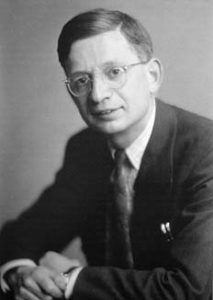
March, 1940 After much prodding by Leo Szilard, Lyman Briggs, head of the Uranium Committee, finally releases a promised $6,000 budgeted for conducting neutron experiments with Enrico Fermi at Columbia University.
March, 1940 Otto Frisch and Rudolf Peierls conclude that only one pound of highly enriched uranium is needed for a bomb.

March 2, 1940 The first direct measurements of the enormous slow fission cross section of uranium-235 are made by John Dunning at Manhattan, NY.
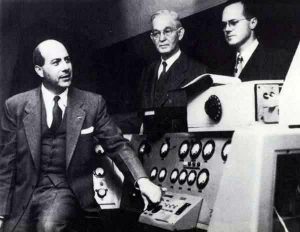
April 9, 1940 Germany invades Denmark and Norway.
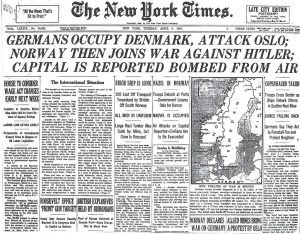
April 10, 1940 First meeting of the British committee (later code-named the MAUD Committee) organized by Henry Tizard to consider Britain’s actions regarding the “uranium problem”. Research into isotope separation and fast fission is agreed upon.
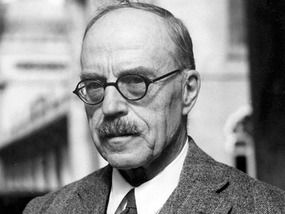
April 27, 1940 Second meeting of Lyman Briggs’ The Uranium Committee. Briggs’ decision is that neither research on fast fission, nor work on building a critical uranium-graphite assembly, should begin until the small scale lab experiments, just getting underway, are finished.

May 1940 George Kistiakowsky suggests gaseous diffusion as a possible means for producing uranium-235 to Vannevar Bush during a meeting at Carnegie Institution.
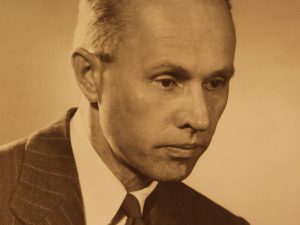
May 10, 1940 Germany launches its assault on Western Europe, attacking Holland, Belgium and France.
May 27, 1940 Louis Turner mails Leo Szilard a manuscript arguing that the isotope of element 94 with 239 nucleons, not yet discovered, should be highly fissionable like uranium-235, and could be manufactured by bombarding uranium-238 with neutrons, to form uranium-239. The same day, Edwin McMillan and Philip Abelson submit the report “Radioactive Element 93” to Physical Review describing their discovery of element 93, neptunium, produced by bombarding uranium with neutrons. Britain subsequently protests the publication as a violation of wartime secrecy.x
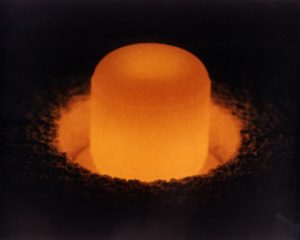
June 1940 The MAUD Committee acquires its name. Franz Simon begins research on isotope separation through gaseous diffusion.
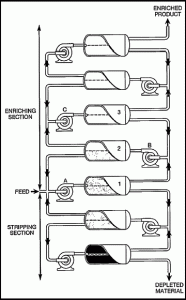
June 27, 1940 The National Defense Research Committee (NDRC) is created to organize U.S. scientific resources for war including research on the atom and the fission of uranium.
July 1, 1940 The newly founded The National Defense Research Committee, headed by Vannevar Bush, takes over responsibility for uranium research. In his final report, Lyman Briggs requests $140,000 for further work: $40,000 for lab measurements, and $100,000 for large scale uranium-graphite studies. Bush approves only $40,000.
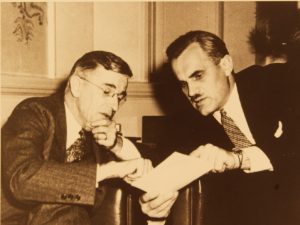
November 1940 John Dunning and Nobel Prize winner Harold Urey begin investigating isotope separation techniques without U.S. government support.
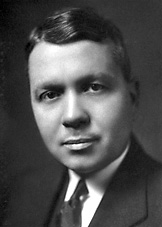
November 1, 1940 The $40,000 contract from the NDRC finally comes through. Work begins at Manhattan, NY to assemble a large subcritical pile made of graphite and uranium oxide.
December 1940 The MAUD Committee issues a report on isotope separation authored by Franz Simon. The report concludes that manufacturing uranium-235 by gaseous diffusion is feasible on a scale suitable for weapons production.
February 1941 Philip Abelson begins working on uranium enrichment at the Naval Research Laboratory. He selects liquid thermal diffusion as the technique to pursue.

February 24, 1941 Glenn Seaborg and his research team discover plutonium.
March 1941 The Department of Terrestrial Magnetism (DTM) at the Carnegie Institution measures the fast cross-section of uranium-235. Using it, Rudolf Peierls, on the MAUD Committee, calculates a new critical mass for uranium-235 at 18 pounds as a bare sphere or 9 to 10 pounds when surrounded by a reflector. A memorandum is prepared by the MAUD Committee describing the importance of fast fission for bomb design and transmits it to the U.S. Briggs locks up the document on arrival and shows it to no one.

March 6, 1941 Glenn Seaborg and Art Wahl isolate the first pure neptunium-239 (0.25 micrograms). In a matter of days it decays into a (barely) visible speck of pure plutonium.
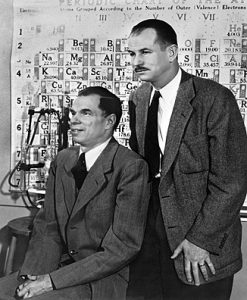
March 28, 1941 Joseph Kennedy, Glenn Seaborg and Emilio Segre show that the plutonium sample undergoes slow fission, which implies it is a potential bomb material.
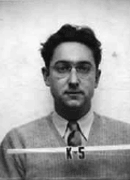
May 1941 After months of growing pressure from scientists in Britain and the U.S. (particularly University of California at Berkeley’s Ernest O. Lawrence), Vannevar Bush at The National Defense Research Committee decides to review the prospects of nuclear energy further and engages Arthur H. Compton and the National Academy of Sciences for the task. The report is issued May 17 and treats military prospects favorably for power production, but does not address the design or manufacture of a bomb in any detail. At this same time, Bush creates the larger and more powerful Office of Scientific Research and Development (OSRD), which is empowered to engage in large engineering projects in addition to research, and becomes its director.
May 1941 Tokutaro Hagiwara at the University of Kyoto delivers a speech in which he discusses the possibility of a fusion explosion being ignited by an atomic bomb, apparently the first such mention.
May 18, 1941 Emilio Segre and Glenn Seaborg determine that the slow cross-section of plutonium-239 is 170% of that of uranium-235, proving it to be an even better prospect for a nuclear explosive.

June 22, 1941 Nazi Germany invades the Soviet Union.
June 28, 1941 The Office of Scientific Research and Development (OSRD) is established. Vannevar Bush is put in charge.
July 1941 Emilio Segre and Glenn Seaborg measure the fast fission cross-section of plutonium-239, finding a high value.
July 15, 1941 The MAUD Committee approves its final report and disbands. The report describes atomic bombs in some technical detail, provides specific proposals for developing them, and includes cost estimates. Although the contents of The MAUD Report reach Vannevar Bush at The Office of Scientific Research and Development immediately, he decides to wait for the report to be transmitted officially before taking any further action on fission development. In short, the report concludes that an atomic bomb is indeed feasible.
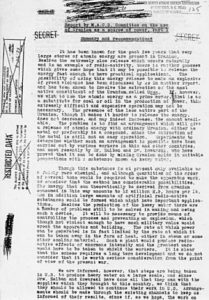
August to September, 1941 Enrico Fermi and his team at Manhattan, NY begin assembling a subcritical experimental pile containing 30 tons of graphite and 8 tons of uranium oxide. It gives a projected k value of 0.83, indicating that purer materials are needed.
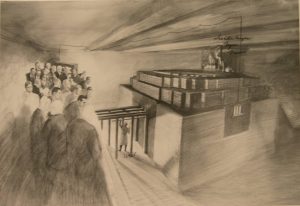
September, 1941 Enrico Fermi muses to Edward Teller whether a fission explosion could ignite a fusion reaction in deuterium. After some study, Teller concludes that it is impossible.
_1-207x300.jpg)
1941 to 1942: Getting Organized
September 3, 1941 With PM Winston Churchill’s endorsement, the British Chiefs of Staff agree to begin development of an atomic bomb.
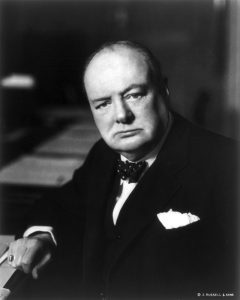
October 3, 1941 The MAUD Report reaches the US through official channels.
October 9, 1941 Vannevar Bush brings The MAUD Report to President Roosevelt for his consideration. FDR asks Bush to determine the cost of an atomic bomb and to explore Army construction needs.
October 12, 1941 Peter L. Kapitza, one of the leaders of Soviet physics, remarked at an international “anti-Fascist” meeting of scientists in Moscow that the recent discovery of nuclear energy could be useful in the war against Germany and that the theoretical prospects of a uranium bomb seemed promising. The Soviet Union would later launch its own atomic program.
October 21, 1941 Arthur H. Compton holds a meeting in Schenectady, NY with Ernest O. Lawrence, J. Robert Oppenheimer, George Kistiakowsky, and James B. Conant reviewing The MAUD Report and the most recent US work. The meeting ends by concluding that an atomic bomb could be made.

November 1, 1941 Arthur H. Compton issues the final NAS report, highlighting the importance of conducting further research on the feasibility of a U-235 bomb. The report is delivered to FDR by Vannevar Bush on November 27.
November 1, 1941 John Dunning and Eugene Booth at Manhattan, NY demonstrate the first measurable U-235 enrichment through gaseous diffusion.
.jpg)
December 6, 1941 Vannevar Bush holds a meeting in Washington to organize an accelerated research project. Arthur H. Compton remains in charge. Harold Urey is appointed to develop gaseous diffusion and heavy water production at Manhattan, NY; Ernest O. Lawrence will investigate electromagnetic separation at the University of California at Berkeley; and Eger Murphree will develop centrifuge separation and oversee engineering issues. James B. Conant advocates pursuing Pu-239, but no decision on this is made.
December 7, 1941 Japan attacks Pearl Harbor.
_burning_after_the_Japanese_attack_on_Pearl_Harbor_-_NARA_195617_-_Edit-300x237.jpg)
December 8, 1941 The US declares war on Japan.
December 11, 1941 The US declares war on Germany and Italy following their declaration of war on the US.
December 18, 1941 The first meeting of the S-1 project is held, sponsored by the OSRD. S-1 is dedicated to the full scale research development of fission weapons.
January 19, 1942 Pres. Roosevelt approves the production of an atomic bomb. Arthur H. Compton creates the Metallurgical Laboratory at the University of Chicago to act as a consolidated research center. He transfers work on “uranium burners” (reactors) to it. J. Robert Oppenheimer organizes a program on fast neutron theoretical physics at the University of California at Berkeley.[Photograph of Compton courtesy of the University of Chicago Photographic Archive, apf1-01862, Special Collections Research Center, University of Chicago Library.]

February 1942 Arthur H. Compton asks Gregory Breit to coordinate physics research on fast neutron phenomena. At this time available experimental data on all aspects of fast neutron reactions and fission is extremely limited and imprecise. Theoretical techniques are also rudimentary.
April 1942 Enrico Fermi relocates to the Chicago Met Lab. He builds an experimental pile in the Stagg Field squash courts with a projected k value of 0.995, then begins planning the construction of the world’s first man-made critical pile, to be called CP-1. Fermi’s efforts now shifts from demonstrating feasibility to securing graphite and uranium of adequate purity and in sufficient quantity to build the reactor.

April 1942 Glenn Seaborg arrives in Chicago and starts work on developing an industrial-scale plutonium separation and purification process. Percival Keith of the Kellogg Co. begins designing a gaseous diffusion pilot plant.
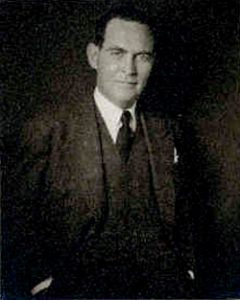
May 18, 1942 Gregory Breit, who has been coordinating physics research on fast neutron phenomena, quits, leaving the neutron physics effort without leadership. Arthur H. Compton asks J. Robert Oppenheimer to take over in his place.

May 19, 1942 Robert Oppenheimer writes Ernest O. Lawrence that the atomic bomb problem was solved in principle and that six good physicists should have the details mostly worked out in six months. His optimism is based on the belief that gun assembly would suffice for both uranium and plutonium.

May 23, 1942 S-1 program leaders discuss priorities. James B. Conant urges proceeding with *all* options for producing fissionable material simultaneously: gaseous diffusion, centrifuge, Electromagnetic Separation, and plutonium breeding using both graphite and heavy water reactors. He argues that redundant development will reduce the time to successful production to the shortest possible time, regardless of cost.

June 1942 J. Robert Oppenheimer leads an effort on fast neutron physics, and prepares an outline for the entire neutron physics program. Production of plutonium through marathon irradiation by cyclotron begins. Chicago Met Lab engineering council begins developing plans for large scale plutonium production reactors. President Roosevelt approves a plan for spending $85 million for a weapon development program.
June 18, 1942 Due to continuing and increasing organizational problems, Col. James Marshall is ordered by Brig. Gen. Wilhelm Styer to organize a U.S. Army Corps of Engineers District to take over and consolidate atomic bomb development.
July to September, 1942 Oppenheimer assembles theoretical study group in Berkeley to examine the principles of bomb design. Included are J. Robert Oppenheimer, Hans Bethe, Edward Teller, John Van Vleck, Felix Bloch, Robert Serber, and Emil Konopinski. During the summer the group develops the principles of atomic bomb design, and examines the feasibility of fusion bombs. Oppenheimer emerges as a natural leader. The group estimates the mass of U-235 required for a high yield detonation at 30 kg (estimated at 100 Kt), megaton range fusion bombs are also considered highly likely. During this period Richard C. Tolman and Robert Serber discuss the idea of using explosives to collapse a shell of fissile material in place of the gun assembly method. Serber reports that they co-authored a short paper on the subject, although this paper has not been found. At this time Enrico Fermi and his staff are busy arranging for the materials required for Chicago Pile 1.
July 27, 1942 First shipment of irradiated uranium arrives at the Chicago Met Lab (300 lb.).
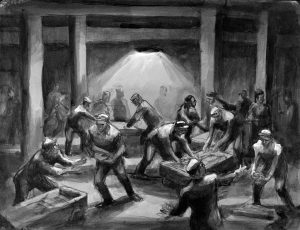
Mid-August 1942 Enrico Fermi’s group demonstrates an experimental pile with a projected k value of close to 1.04. Achieving a chain reaction is now certain.
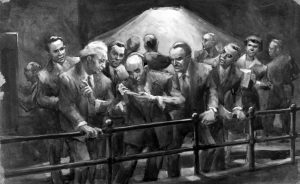
August 13, 1942 The Manhattan Engineer District is formally established.
August 20, 1942 Glenn Seaborg isolates pure plutonium through a separation process suitable for industrial scale use.
August 29, 1942 A status report by James B. Conant is relayed to the Secretary of War by Vannevar Bush indicating the very positive results of Oppenheimer’s group. Bush adds his concerns about the organization and leadership of the project, requesting new leadership be appointed.
1942 to 1943: Early Manhattan Project
May 15, 1942 President Franklin D. Roosevelt signs into law legislation creating the Women’s Army Auxiliary Corps (converted into the Women’s Army Corps in 1943).
1942 Sept 13 The S-1 Executive Committee recommends building a pilot plant based on Ernest O. Lawrence’s cyclotrons to separate uranium isotopes in Tennessee.
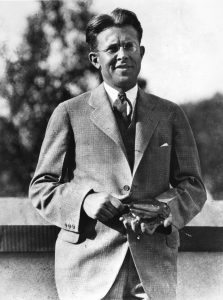
1942 Sept 15 Starting on this date, and continuing until November 15, Enrico Fermi’s group receives shipments of uranium and graphite for CP-1 and prepares them for assembly.
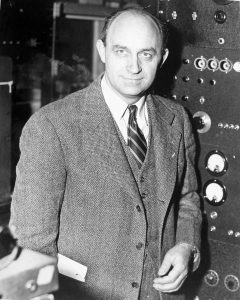
1942 Sept 17 Col. Leslie Groves is notified at 10:30 a.m. by Gen. Brehon Somervell that his assignment overseas has been cancelled and that he will take another assignment – command of the Manhattan Engineer District. Groves’ previous assignment had required overseeing ten billion dollars’ worth of construction projects, including the construction of the Pentagon.
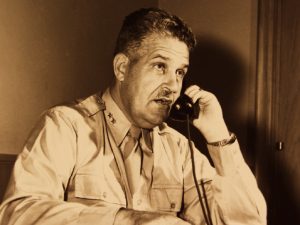
1942 Sept 18 Col. Leslie Groves buys 1250 tons of high quality Belgian Congo uranium ore stored on Staten Island.
1942 Sept 19 Col. Leslie Groves selects Oak Ridge, TN as the site for the pilot plant. He buys Site X, 52,000 acres of land on the Clinch River. Preliminary construction work begins soon after.
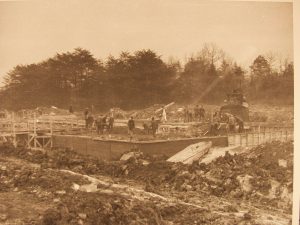
1942 Sept 19 At Col. Leslie Groves’ insistence the Manhattan Project is granted approval by the War Production Board to use the highest emergency procurement priority in existence (AAA) when needed.
1942 Sept 23 Col. Leslie Groves is promoted to Brigadier General.
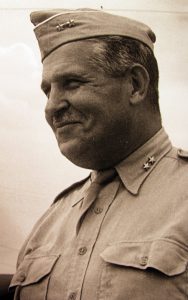
1942 Sept 29 J. Robert Oppenheimer proposes that a “fast-neutron lab” to study fast neutron physics and develop designs for an atomic bomb be created. The idea at this point is for the lab to be a small research institution that would not be involved in the engineering and production of nuclear weapons.
1942 Oct Gen. Leslie Groves puts DuPont in charge of the plutonium production project.

1942 Oct James B. Conant recommends to Vannevar Bush that information exchange with Britain, already largely one-way (UK –> US), be sharply restricted. Bush passes this recommendation to President Roosevelt. As a result the US loses access to British work in gaseous diffusion, which seriously delays successful plant completion.
1942 Oct Centrifuge separation is abandoned due to technical problems.
1942 Oct 5 Gen. Leslie Groves visits the Chicago Met Lab and meets the key scientists, including J. Robert Oppenheimer. He orders key engineering decisions for plutonium production, under debate for months, be made in 5 days.
1942 Oct 15 Gen. Leslie Groves asks J. Robert Oppenheimer to head Project Y, planned to be the new central laboratory for weapon physics research and design.
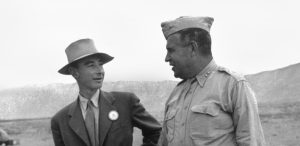
1942 Oct 19 Vannevar Bush approves J. Robert Oppenheimer’s appointment in meeting with Oppenheimer and Gen. Leslie Groves.
1942 Nov 3 Glenn Seaborg reports that due to plutonium’s high alpha activity, slight amounts of light element impurities can cause a serious problem with neutron emission from alpha -> n reactions. This issue caused major concern with many project leaders, including Leslie Groves and James B. Conant, not only due to its own significance, but because it raised apprehension about the impact of other unexplored phenomena. (This issue later became moot due to the problems with Pu-240 contamination). Later in the month the Lewis Committee is formed to review progress and make recommendations.
1942 Nov 12 The Military Policy Commission decides to skip the pilot plant stages and go directly from research to industrial-scale production.
1942 Nov 16 Enrico Fermi’s group begins constructing Chicago Pile-1 at Stagg Field using round-the-clock shifts. Also, Groves and Oppenheimer visit the Los Alamos, NM mesa in New Mexico and select it for “Site Y.”
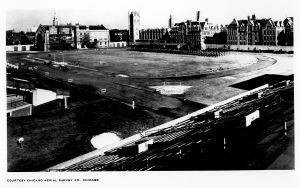
1942 Nov 25 General Leslie Groves selects Los Alamos, NM as the site for a scientific research laboratory, codenamed “Project Y”. J. Robert Oppenheimer is selected as laboratory director.
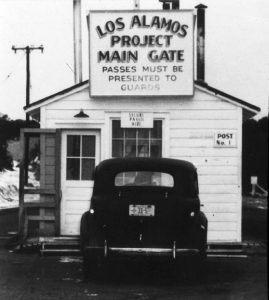
1942 Dec During this month the work on gaseous diffusion is reorganized. On the strength of the Lewis Committee’s recommendation, gaseous diffusion is chosen as the principal enrichment approach. Kellex Corporation, a subsidiary of Kellog is created to build a plant, Percival Keith is put in charge. Contracts are put in place, and hiring begins for plant construction. Kellex immediately begins work on a process for producing usable barrier material on an industrial scale.

1942 Dec Vannevar Bush provides Roosevelt with an estimate placing the total cost for the Manhattan Project at $400 million (almost 5 times the previous estimate). Roosevelt approves the expenditure.
1942 Dec Plans and contracts are made for the construction of an experimental reactor, plutonium separation plant, and Electromagnetic separation facility at Oak Ridge, TN.
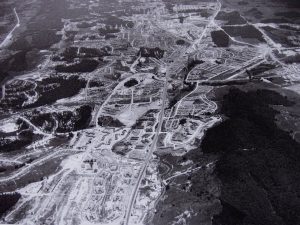
1942 Dec 1 After 17 days of work, Enrico Fermi’s group completes Chicago Pile-1. It contains 36.6 metric tons of uranium oxide, 5.6 metric tons of uranium metal, and 350 metric tons of graphite. Construction is halted sooner than planned when Fermi projects that a critical configuration has been reached.
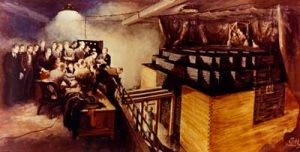
1942 Dec 2 At 3:49 p.m., CP-1 goes critical. It demonstrates a k value of 1.0006, and is allowed to reach a thermal output of 0.5 watts (ultimately it operates at 200 watts maximum). This is the first sustained nuclear fission chain-reaction with the Chicago Pile-1 (CP-1).
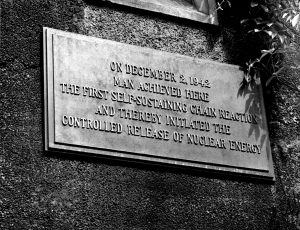
1942 Dec 6 M. M. Sundt Company is appointed contractor to build Los Alamos Laboratory in a handshake deal. Sundt begins construction immediately, without plans or blueprints in order to finish as quickly as possible.
1943 Jan 16 General Leslie Groves selects Hanford, WA as a site for plutonium production.
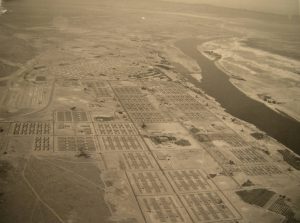
1943 Feb The Soviet Union secretly launches its own atomic program under the direction of Igor Kurchatov. The program was extremely limited throughout the war and included no more than fifty personnel.
-221x300.gif)
1943 Feb 18 Construction begins at Oak Ridge, TN on buildings for the Y-12 Plant — the electromagnetic U-235 separation plant.
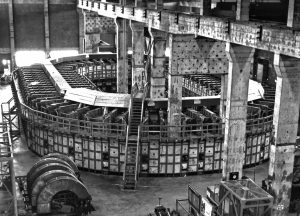
1943 Mar The original construction program nears completion, and staff begins arriving at Los Alamos, NM to begin operations. From this point on the site grows non-stop through the end of the war.
1943 Mar 27 Richard Tolman writes J. Robert Oppenheimer about using explosives to collapse a shell into a critical mass. This is the earliest surviving reference to the idea of implosion (although this term was not used).
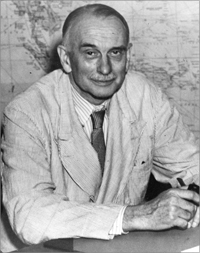
1943 April Los Alamos, NM provides its scientists introductory lectures on nuclear physics and bomb design.
1943 April At the beginning of the month the original building plan for Los Alamos, NM is 96% complete. It is already apparent that the original construction program is inadequate to meet needs.
1943 April A series of staff conferences among the roughly 100 scientific staff members are held at Los Alamos, NM. These include indoctrination lectures by Robert Serber (later published as The Los Alamos Primer) on April 5, 7, 9, 12, and 14; and meetings to plan the laboratory’s work from April 15 through May 6. The laboratory’s initial organization and leadership is worked out.
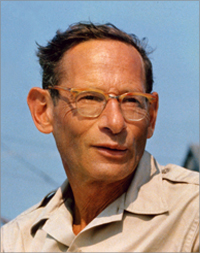
1943 April Seth Neddermeyer begins research on implosion, seeking to compress hollow metal assemblies.
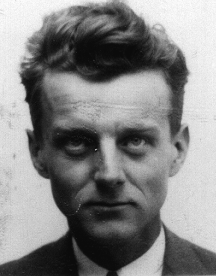
1943 April Hans Bethe is selected over Edward Teller to head the theoretical division. Teller is soon placed in charge of lower priority research on fusion weapons.

1943 April J. Robert Oppenheimer projects that 100 g of 25% enriched U-235 will be produced by Electromagnetic Separation by 1 Jan. 1944.
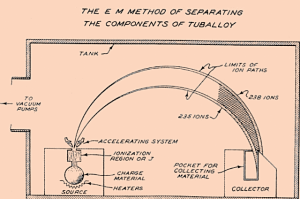
1943 April By the end of the March planning sessions, the necessity of including ordnance development activity at Los Alamos was apparent. This greatly expanded the scope of work undertaken at the laboratory to engineering development, and eventually acting as prime contractor for weapon production, and manufacturer of key weapon components (including all nuclear components, and the implosion system).
1943 April 1 Fencing of the reservation completed — Oak Ridge, TN is closed off to public access. Also, construction begins on plant for manufacturing gaseous diffusion barriers in Decatur, IL although no barrier materials of usable quality have yet been produced.
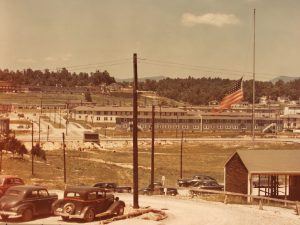
1943 April 20 A contract is concluded with the University of California to manage Los Alamos, NM acting as paymaster, accountant, and procurement agency. This contract (back dated to Jan. 1 for work already performed) served as the basis for University of California management of both the Los Alamos and Lawrence Livermore laboratories.
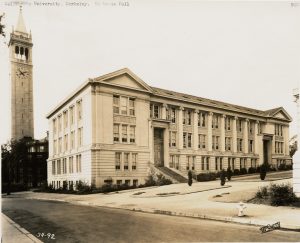
1943 May 10 The Los Alamos, NM review committee approves the laboratory’s research program.
1943 May 31 Surveying begins for the K-25 Plant, the gaseous diffusion uranium enrichment plant at Oak Ridge, TN.
1943 June K-25 Plant construction begins in Oak Ridge, TN.
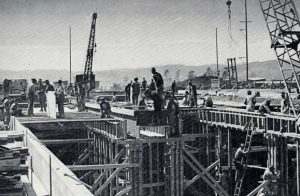
1943 June Navy Capt. William Parsons arrives at Los Alamos, NM as Ordnance Division leader to begin directing gun assembly research.
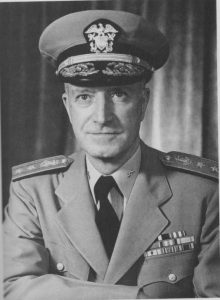
1943 June 24 Working with cyclotron produced plutonium, Emilio Segre determines that the spontaneous fission rate is 5 fissions/kg-sec. This is well within the assembly speed capability of a high speed gun.

1943 July 4 Seth Neddermeyer conducts first explosion in the implosion research program (currently consisting of Neddermeyer, and 3 informal assistants).
1943 July 10-15 The first nuclear physics experiment is conducted at Los Alamos, NM (the measurement of Pu-239 fission neutron yield), inaugurating it as a functioning laboratory.
1943 Aug Despite the efforts of more than 1000 researchers at Kellex and Columbia University, no suitable gaseous diffusion barrier material has yet been developed.
1943 Aug Due to lagging progress on gaseous diffusion, and continuing uncertainties about the required amount of U-235 for a bomb, General Leslie Groves decides to double the size of the Y-12 Plant.

1943 August The first Alpha Electromagnetic Separation unit for uranium begins operation. Construction staff at Oak Ridge, TN now exceeds 20,000. Also, construction begins on the cooling systems for the production reactors at Hanford, WA. Construction staff is about 5,000.
1943 Aug President Franklin Roosevelt and Winston Churchill sign the Quebec Agreement.
-300x223.jpg)
1943 Sept 8 Italy surrenders to Allied forces.
1943 Sept 17 First shot fired in gun assembly research program at Los Alamos, NM. The focus at this point is on developing a high velocity gun for plutonium since a uranium gun would be much easier to make.
1943 Sept 20 John von Neumann arrives on a visit to Los Alamos, NM and points out the potential for high compression from implosion. This is a clear advantage for the technique which would make a bomb more efficient, and require a smaller critical mass. Edward Teller and Hans Bethe begin investigating the subject theoretically, J. Robert Oppenheimer and General Leslie Groves become very interested in its potential, and efforts to accelerate the program begin. John von Neumann agrees to work on the physics of implosion in his spare time.
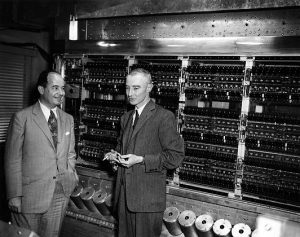
1943 Sept 23 J. Robert Oppenheimer suggests recruiting George Kistiakowsky, the leading explosives research director at The Office of Scientific Research and Development, to aid an expanded implosion effort.
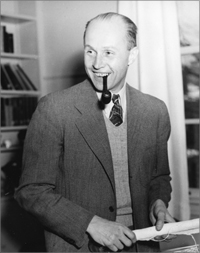
1943 Oct The first Alpha racetrack (containing 96 units) is completed. A work force of 4800 to run the Y-12 Plant has been assembled. Startup is unsuccessful due to unexplained shorts in the magnets.

1943 Oct Project Alberta, the full scale atomic bomb delivery program, begins. Norman Ramsey appointed to select and modify aircraft for delivering atomic bombs.
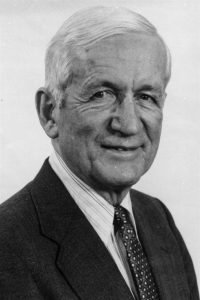
1943 Oct 4 DuPont engineers release reactor design drawings for the first Hanford, WA plutonium production pile, 100-B, allowing construction to begin.
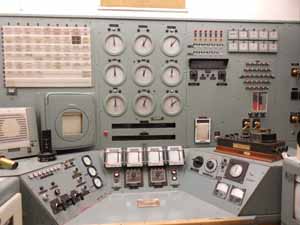
1943 Oct 10 Site preparation starts for the B-100 plutonium production reactor, B Reactor, at Hanford, WA.
1943 Oct 21 First concrete is poured for the K-25 Plant building at Oak Ridge, TN.
1943 Nov The top experts in England on fission weapons, many former members of the MAUD committee, depart England for the US to assist the atomic bomb project. Included are Niels Bohr, Otto Frisch, Rudolf Peierls, James Chadwick, William Penney, George Placzek, Philip B. Moon, James Tuck, Egon Bretscher, and Klaus Fuchs.
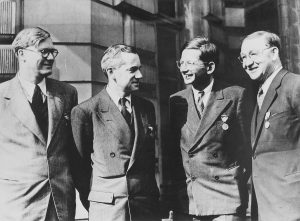
1943 Nov The Navy approves Philip Abelson’s plan to build a liquid thermal diffusion pilot plant for enriching uranium, the S-50 Plant.
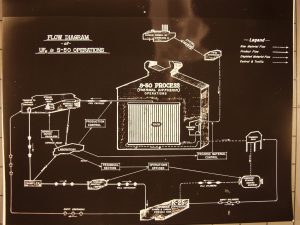
1943 Nov The world’s first sample of plutonium in metal form is produced by reducing PuF4 with Ba at the Chicago Met Lab.
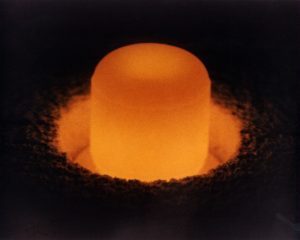
1943 Nov 4 The X-10 Graphite Reactor pile goes critical at Oak Ridge, TN. This air-cooled experimental pile begins producing the first substantial (gram) amounts of plutonium to assist research into its properties. The world supply of plutonium at this time is 2.5 mg, produced by cyclotrons. Also, a Manhattan Project Governing Board meeting approves an ambitious implosion research program, intended to develop it to the point of usability in six months.

1943 Nov 29 The first B-29 modifications begin at Wright Field, Ohio to adapt it for carrying atomic bombs.
1943 Dec After attempts to bring the first Alpha racetrack into operation fail, the Y-12 Plant is shut down for equipment rebuilding.
1943 Dec Emilio Segre measures the spontaneous fission rate of U-235 at Los Alamos, NM, and finds it lower than expected. This allows a substantial reduction in performance of the planned gun assembly method for uranium.

1943 Dec Chemical separation of reactor-produced plutonium begins, using fuel from the X-10 Graphite Reactor pile.
1944: Developing the Bomb
1944 Jan George Kistiakowsky arrives at Los Alamos, NM to assist Seth Neddermeyer in implosion research. It becomes increasingly clear that Neddermeyer’s academic research style is unsuited to directing a rapidly expanding research and engineering program.
1944 Jan Problems with developing suitable diffusion barriers leads General Leslie Groves to switch planned production to a new type of barrier, creating months of delays in equipping the K-25 Plant for operation.
1944 Jan Philip Abelson, after learning about the problems with the Manhattan Project’s gaseous diffusion plant, informs J. Robert Oppenheimer about the progress in his research on liquid thermal diffusion technology. This eventually leads to the construction of the S-50 Plant at Oak Ridge.

1944 Jan General Leslie Groves and J. Robert Oppenheimer decide to plan for a fission bomb test (none was envisioned before this). Groves stipulates that the active material must be recoverable if a fizzle occurs, so the construction of Jumbo, a 214 ton steel container (25 ft x 12 ft), is authorized.
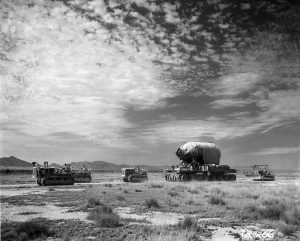
1944 Sept 16 The S-50 Plant begins partial operation at Oak Ridge, TN, but leaks prevent substantial output.
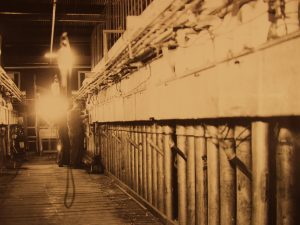
1944 Jan 11 An implosion theory group is set up with Edward Teller as head.
-207x300.jpg)
1944 Feb With the concrete building to house it complete, construction begins on the first reactor at Hanford, WA, the B Reactor.
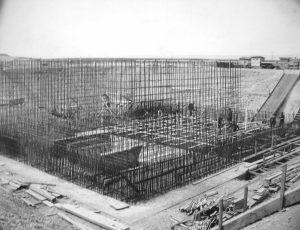
1944 Feb The Los Alamos Governing Board reevaluates deuterium fusion research and determines that tritium would be necessary to make an explosive reaction. Priority of fusion bomb work is further downgraded.
1944 Feb The Y-12 Plant sends 200 grams of uranium-235 to Los Alamos, NM.
1944 Feb 16 George Kistiakowsky becomes a full-time Los Alamos staff member, replacing Seth Neddermeyer as leader of implosion research.

1944 May Six months after the start of accelerated implosion research, little progress towards successful implosion has been made. Inadequate diagnostic equipment prevent accurate measurement of implosion process, and no scheme to avoid asymmetry has yet shown promise. The current approach is to use many simultaneous detonation points over the surface of a sphere, and try different methods of inert spacers or gaps to suppress the shaped charge-like jets that form when detonation waves from adjacent initiation points merge. Spalling (the ejection of fragments) from the interior surface of the hollow core is a serious problem, as is simply getting precise simultaneous detonation.
1944 Mar Emilio Segre has improved his spontaneous fission estimates in cyclotron plutonium (essentially pure Pu-239) to 11 fissions/kg-sec. This is still acceptable for gun assembly, but greatly narrows the margin of security.

1944 Mar 3 Drop tests of dummy atomic bombs begin from specially modified B-29s at Wendover, Utah.
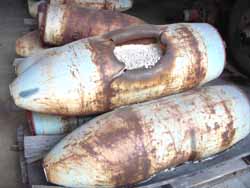
1944 Apr IBM calculating equipment arrives at Los Alamos, NM and is put to work on implosion research.
1944 Apr James Tuck suggests idea of using explosive lenses to create spherical converging implosion waves.

1944 April Monsanto at Dayton, OH begins delivering polonium for initiator research. The rate is initially 2.5 curies/month.
1944 Apr 5-15 On April 5 the first sample of reactor produced plutonium arrives from Oak Ridge, TN. Emilio Segre immediately begins monitoring its spontaneous fission rate. By April 15 he makes a preliminary estimate of a spontaneous fission rate of over 50 fissions/kg-sec (due to Pu-240 contamination), far too high for gun assembly. The report is kept quiet due to limited statistics, and observations continue.
1944 May Los Alamos, NM staff exceeds 1200 employees.

1944 May Edward Teller is removed as head of the implosion theory group, and also from fission weapon research entirely, due to conflicts with Hans Bethe and his increasing obsession with the idea of the Super (hydrogen bomb).

1944 May Two British scientists join Los Alamos, NM, and prove to have important impacts on the implosion program. Geoffrey Taylor (arrived May 24) points out implosion instability problems (especially the Rayleigh-Taylor instability), which ultimately leads to a very conservative design to minimize possible instability. James Tuck brings the idea of explosives lenses for detonation wave shaping (2-D lenses for plane wave generation originally proposed by M. J. Poole in England, 1942), but suggests developing 3-D lenses to create a spherical implosion.

1944 May 9 The 50 milliwatt Water Boiler reactor goes critical at Los Alamos, NM. Holding 565 g of U-235 (in the form of 14.7% enriched uranyl sulfate), dissolved in a 12″ sphere of water, this is the world’s first reactor to use enriched uranium, and the first critical assembly constructed at Los Alamos.
1944 May 28 First test of the exploding wire detonator, used to achieve precise, reliable simultaneous detonation for implosion.
1944 June J. Robert Oppenheimer replaces Seth Neddermeyer with George Kistiakowsky as director of implosion research.
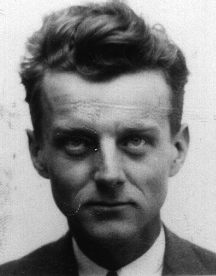
1944 June Hans Bethe and Rudolf Peierls work on developing explosive lens concept.

1944 June John von Neumann provides design breakthrough for the slow component for focusing.
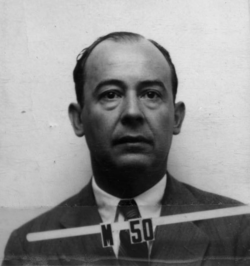
June 3, 1944 After visiting the uranium enrichment pilot plant at the Naval Research Laboratory, a team of Manhattan Project experts recommends that a liquid thermal diffusion plant be built to feed enriched material to the electromagnetic enrichment plant at Oak Ridge, the S-50 Plant.

1944 June 6 Allied forces launch the Normandy invasion.

1944 June 18 General Leslie Groves contracts to have the S-50 Plant, intended for liquid thermal diffusion uranium enrichment, built at Oak Ridge, TN in no more than three months.
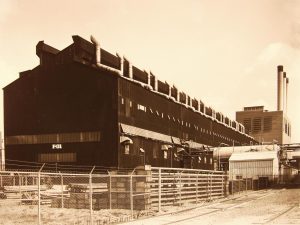
1944 July Experiments with explosive lens designs begin by mid-month when 2-D models are fired.
1944 July The design for the gun gadget neutron initiator is completed.
1944 July Scientists at the Chicago Met Lab issue the “Prospectus on Nucleonics,” which concerns the international control of atomic energy.
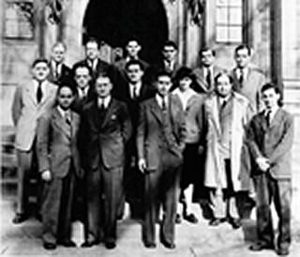
1944 July Air Force Lt. Col. Paul Tibbets begins organizing the 509th Composite Group, which will deliver atomic bombs in combat, at Wendover Field, Utah.
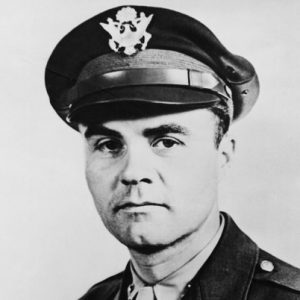

1944 July 4 J. Robert Oppenheimer reveals Emilio Segre’s spontaneous fission measurements to the Los Alamos, NM staff. The neutron emission for reactor-produced plutonium is too high for gun assembly to work. The measured rate is 50 fissions/kg-sec, the fission rate in Hanford, WA plutonium is expected to be over 100 times higher still. The discovery of the high spontaneous fission rate of reactor-produced plutonium was a turning point for Los Alamos, NM, the Manhattan Project, and eventually for the practice of large-scale science after the war. The planned plutonium gun had to be abandoned, and J. Robert Oppenheimer was forced to make implosion research a top priority, using all available resources to attack it. A complete reorganization of Los Alamos Laboratory is required. With just 12 months to go before expected weapon delivery a new fundamental technology, explosive wave shaping, has to be invented, made reliable, and an enormous array of engineering problems had to be solved. During this crisis the many foundations for post-war science were laid. Scientist-administrators (as opposed to academic or research scientists) came to the forefront for running large scale research efforts. Automated numerical techniques (as opposed to manual analytical ones) were applied to solve important scientific problems, not just engineering applications. The dispersal of key individuals after the end of the war later carried these insights, as well as the earlier organizational principles developed at Los Alamos throughout American academia and industry.

1944 Aug The Air Force begins modifying 17 B-29s for combat delivery of atomic weapons at the Glenn L. Martin plant in Omaha, Nebraska.
1944 Aug Deak Parsons assesses February 1945 as the earliest an implosion lens system can be ready for full scale test “with extremely good breaks”, and most likely late 1945.

1944 Aug A. Francis Birch takes over the uranium gun project.
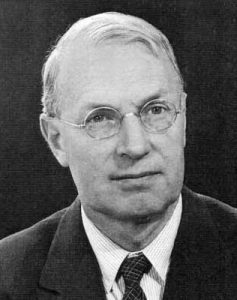
1944 Sept At this point the K-25 Plant is half built, but no usable diffusion barriers have been produced. The Y-12 Plant is operating at only 0.05% efficiency. The total production of highly enriched uranium to date is a few grams.

1944 Sept During the fall Robert Christy suggests the “Christy gadget”, the use of a solid core that is raised to supercriticality solely by compressing the metal to twice normal density. This conservative implosion design avoids instability and spalling problems, but the period of maximum compression is brief and requires a “modulated initiator” (a neutron generator that emits a burst at a precise moment). Earlier shell designs could have relied on spontaneous fission and still achieved reasonable efficiency.

1944 Sept President Franklin Roosevelt and British Prime Minister Winston Churchill sign the Hyde Park aide-memoire, pledging to continue researching atomic technology.
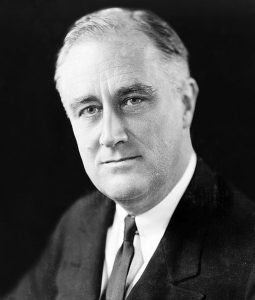
1944 Sept 22 The first RaLa implosion test shot is made in Los Alamos, NM. This diagnostic technique used 100 curies of radiolanthanum produced by the X-10 Graphite Reactor at Oak Ridge, TN to provide an intense gamma source for making observations of implosion (essentially an internal x-ray generator). This is the largest radioisotope source ever assembled in the world up to this time.

1944 Sept 26 Loading uranium into the first full scale plutonium reactor, the B Reactor, at Hanford, WA is completed. This reactor contains 200 tons of uranium metal, 1200 tons of graphite, and is cooled by 5 m^3 of water/sec. It designed to operate at 250 megawatts, producing some 6 kg of plutonium a month. Fermi supervises reactor start-up.

1944 Sept 27-30 After several hours of operation at 100 megawatts, the B Reactor pile inexplicably shuts down, then starts up again by itself the next day. Within a few days this is determined to be due to poisoning by the highly efficient neutron absorber Xenon-135, a radioactive fission product. The reactor must be modified to add extra reactivity to overcome this effect before production can begin.
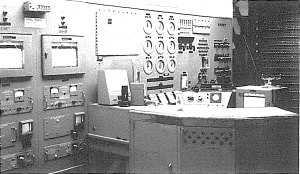
1944 Oct 12 The first B-29s arrive in the Mariana Islands to begin bombing Japan. Japan has so far remained free from air attacks (except for the symbolic Doolittle raid in 1942).
1944 Oct 27 J. Robert Oppenheimer approves plans for a bomb test in the Jornada del Muerto valley at the Alamagordo Bombing Range. General Leslie Groves approves 5 days later, provided that the test be conducted in Jumbo.
1944 Nov Y-12 Plant output has reached 40 grams of highly enriched uranium a day.
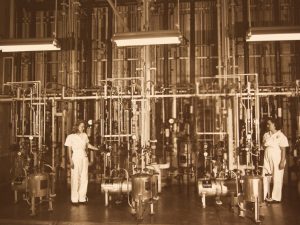
1944 Nov 24 The first B-29 raid on Japan begins. 100 planes are launched, only 16 bombs hit the target factory.
1944 Dec Y-12 Plant output climbs to 90 grams of highly enriched uranium a day.
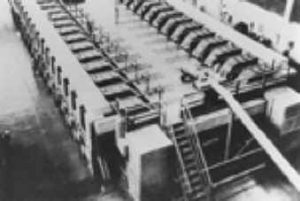
1944 Dec Work begins on an implosion initiator for the solid core bomb, it is not clear at this point if one can be made.
1944 Dec First successful explosive lens tests conducted at Los Alamos, NM, establishing the feasibility of making an implosion bomb.
1944 Dec 8 Polish Physicist Joseph Rotblat resigns from the Manhattan Project upon learning that an American atomic bomb will not be used against Nazi Germany.

1944 Dec 17 The D pile goes critical at Hanford, WA with sufficient reactivity to overcome fission product poisoning effects. Large scale plutonium production begins.

1944 Dec 22 First Fat Man bomb assembly is completed as production gets underway. Explosive lenses and nuclear material are not yet available, the bomb assemblies are used for airdrop and ground handling practice.
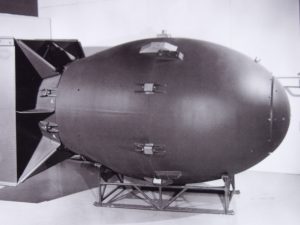
1944 Dec 26 Processing of irradiated uranium slugs to separate plutonium begins at Hanford, WA.
1944 Dec 28 The modified B Reactor pile is restarted.
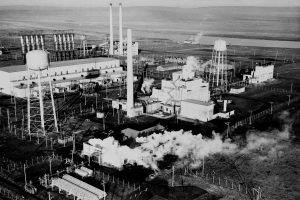
1945: Building the Bomb
1945 Jan Y-12 Plant output reaches an average of 204 grams of 80% U-235 a day; projected production of sufficient material for a bomb (~40 kg) is July 1.

1945 Jan Usable barrier tubes begin arriving at the K-25 Plant.

1945 Jan 160 g of plutonium from the X-10 Graphite Reactor is on hand at Los Alamos, NM. The first shipment from Hanford, WA has not yet arrived.

1945 Jan Substantial production of ~0.85% enriched uranium begins at the S-50 Plant, with ten of 21 racks going in to operation.
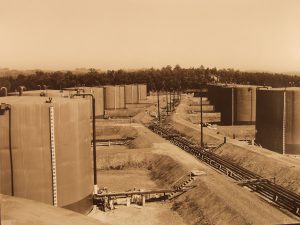
1945 Jan 18 The Dragon experiment conducted by Otto Frisch, in which a U-235 hydride slug is dropped through a barely subcritical U-235 hydride assembly, creates the world’s first assembly critical through prompt neutrons alone (prompt critical). The largest energy production for a drop is 20 megawatts for 3 milliseconds (the temperature rises 6 degrees C in that time).

1945 Jan 20 Curtis LeMay takes command of the Twentieth Air Force in the Marianas. The fleet contains 345 aircraft, but in three months of bombing none of the nine top priority targets have been destroyed. Also, the first stage of the K-25 Plant is charged with uranium hexafluoride and begins operation.

1945 Jan 31 Robert Bacher reports to Oppenheimer that a Po-210/Be-9 implosion initiator (still to be designed) is possible.
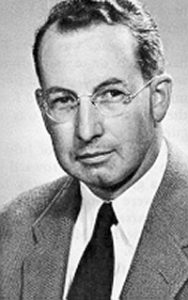
1945 Feb Initiator tests begin. Demand for polonium from Dayton, OH rises to 100 curies/month.
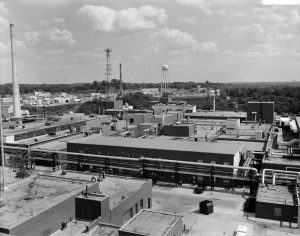
1945 Feb Admiral Nimitz, Commander in Chief, Pacific Ocean Areas, is notified of the nature of the atomic bomb project.

1945 Feb Tinian Island is selected as the base of operations for atomic attack.
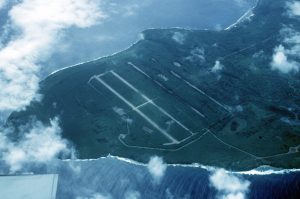
1945 Feb The F reactor goes on-line at Hanford, WA, raising theoretical production capacity to 21 kg/month.
1945 Feb Uranium gun design is completed and frozen. Only planning for deployment and combat use once the U-235 is delivered is now required (although studies of an improved gun design, begun on Dec. 7 and later abandoned, are underway).
1945 Feb Planning for an implosion bomb test begins in earnest.
1945 Feb 2 Los Alamos, NM receives its first plutonium from Hanford, WA.
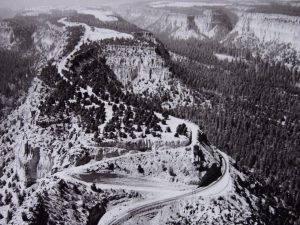
1945 Feb 13 Dresden, Germany is burned down in an incendiary raid killing 50,000.
1945 Feb 19 Marines land on Iwo Jima, a Japanese observation post for the B-29 raids. Over the next two months 6,281 marines are killed, and 21,865 are wounded in capturing the island from 20,000 defenders.
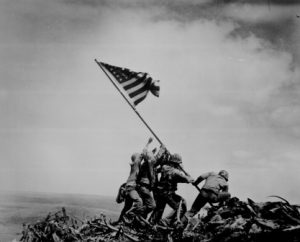
1945 Feb 20 First stage of the K-25 Plant begins operating.
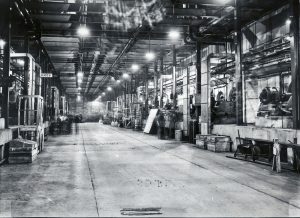
1945 Feb 23 A fire bomb test raid on Tokyo with 172 planes burns one square mile, the most destructive raid on Japan to date.

1945 Feb 28 A meeting between J. Robert Oppenheimer, General Leslie Groves, George Kistiakowsky, James B. Conant, Richard Tolman, Hans Bethe, and Charles Lauritsen is held to fix the design approach for the plutonium bomb. It is agreed that work will focus on the solid core Christy gadget, use explosive lenses, use a modulated initiator, and electric detonators. The use of Composition B and Baratol for the lenses was also decided, as was the multiple lens configuration and detonator arrangement. However none of these approaches or components have been proved yet. Solid core compression has not been demonstrated at this time. A schedule for completing research, development, engineering, and testing is also established. The (partial) goals are:Solve detonator timing problem, have detonators in full production, and begin large-scale lens production (Apr 15).Begin hemisphere shots to measure shock wave convergence (Apr 25).Demonstrate implosion compression in full scale test (May 15).Begin lens fabrication for The Trinity Test (June 4).Begin assembly of The Trinity Test Gadget (July 4).

1945 Mar 1 The powerful Cowpuncher Committee is organized to “ride herd” on implosion bomb development.
1945 Mar The first evidence of solid compression from implosion is observed (5%).
1945 Mar 5 J. Robert Oppenheimer officially freezes explosive lens design.

1945 Mar 9-10 General Curtis LeMay launches an all-out low altitude firebomb raid on Tokyo with 334 B-29s. Flames engulf 15.8 square miles of the city, killing about 100,000 people and injuring 1,000,000 (41,000 seriously).
1945 Mar 11-18 During these eight days fire raids with similar tactics are launched on Nagoya, Osaka, and Kobe; the second, third, and fourth largest cities in Japan. An additional 16 square miles of city are burned, killing more than 50,000 people.
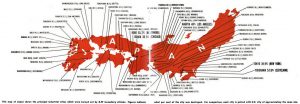
1945 Mar 12 K-25 Plant begins production in Oak Ridge, TN.
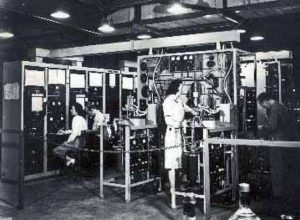
1945 Mar 15 All 21 racks at the thermal diffusion sector at the S-50 Plant finally in operation.
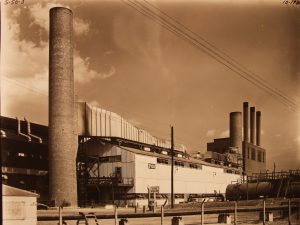
1945 Apr 3 Preparations begin at Tinian Island to support the 509th Composite Group, and to assemble the atomic bombs.

1945 Apr 11 Robert Oppenheimer reports that George Kistiakowsky has achieved optimal performance with implosion compression in sub-scale tests.

1945 Apr 12 Otto Frisch completes criticality and “zero-yield” experiments with U-235 at Los Alamos, NM. Also, President Roosevelt dies and Harry S. Truman become president.

1945 Apr 13 President Harry Truman learns of the existence of atomic bomb development from Secretary of War Henry Stimson.
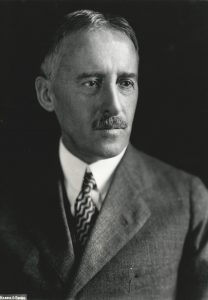
1945 Apr 27 The first meeting of the Target Committee to select targets for atomic bombing. Seventeen targets are selected for study: Tokyo Bay (for a non-lethal demonstration), Yokohama, Nagoya, Osaka, Kobe, Hiroshima, Kokura, Fukuoka, Nagasaki, and Sasebo (some of these are soon dropped because they had already been burned down).
1945 Apr 30 Initiator Committee (Hans Bethe, Enrico Fermi and Robert Christy) selects the most promising design for fission initiator (neutron generator) to be used in the implosion bomb. The “Urchin” design is favored, and work on initiator fabrication begins. Also, first batch of supplies for the atomic bomb deployment leaves for Tinian Island from Wendover, Utah.
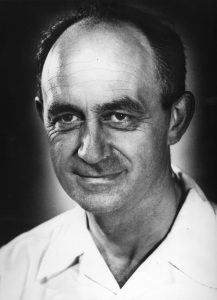
1945 May Little Boy is ready for combat use, except for the U-235 core. It is estimated sufficient material will be available by 1 August.
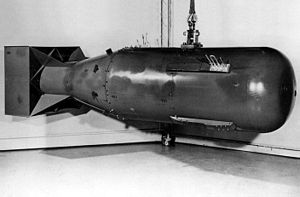
1945 May 31 Critical mass tests with plutonium begin at Los Alamos, NM.
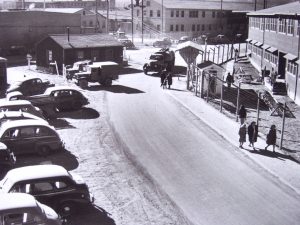
1945 May 2 The first Raytheon Mark II X-Unit arrives for detonation testing.
1945 May 7 The 100-ton test is conducted. 108 tons of TNT, laced with 1000 curies of reactor fission products, are exploded 800 yards from Trinity ground zero to test instrumentation for The Trinity Test. This is the largest instrumented explosion conducted up to this date. Also, Nazi Germany surrenders to the Allies.

1945 May 9 General procedures for atomic bombing are completed by D.M. Dennison, under Deak Parsons.

1945 May 10-11 Target Committee reconvenes. On the committee now are J. Robert Oppenheimer, John von Neumann, Deak Parsons, and Hans Bethe. Meeting discusses issues combat employment of atomic bombs (e.g. proper burst height, etc.). Target list is shortened to Kyoto, Hiroshima, Yokohama, and Kokura Arsenal (Niigata is considered).

1945 May 25 464 B-29s raid Tokyo again, burning out nearly 16 square miles of the remaining city. Only a few thousand are killed, urban inhabitants have learned to flee fire bomb attacks quickly and escape the flames. Also, Operation OLYMPIC, the invasion of Kyushu (the southern Japanese island), is set for November 1.
1945 May 28 Target Committee meets with Lt. Col. Paul Tibbets in attendance. The meeting reviews preparation for delivering atomic bombs, and status of conventional bombing of Japan. Tibbets estimates that by Jan. 1, 1946 all major cities of Japan will have been destroyed by fire bombing. The target list is now Kyoto, Hiroshima, and Niigata.

1945 May 30 Secretary of War Henry Stimson rules out Kyoto, the ancient capital of Japan, as a target for atomic attack.
1945: Ending the War
1945 June Curtis LeMay estimates that the Twentieth Air Force will finish destroying the 60 most important cities in Japan by Oct. 1. Also, the T-5 group in the Los Alamos T (Theory) Division estimates The Trinity Test explosion yield at 4-13 Kt.
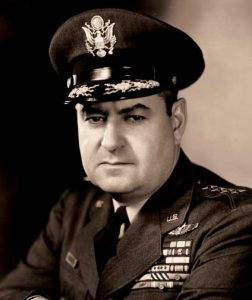
1945 June Scientists begin circulating Franck Report, which urges demonstration of the bomb prior to military use.
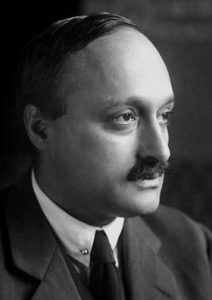
June 1945 The Interim Committee, organized to guide the final conduct of the war and the post-war reconstruction and led by Secretary of State Designate James Byrnes, issues the recommendations that the atomic bomb be dropped as soon as possible, that an urban area be the target, and that no prior warning be given.

1945 June 10 509th Composite Group crews begin arriving on Tinian Island with their modified B-29s.
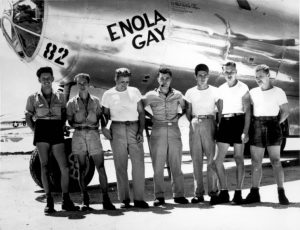
1945 June 14 General Leslie Groves submits the target selections to General George Marshall.

June 16 1945 The Scientific Panel of the Interim Committee, which includes Enrico Fermi, J. Robert Oppenheimer, Arthur Compton, and Ernest Lawrence, reports that it sees “no acceptable alternative” to the use of an atomic weapon against Japan.
1945 June 21 The first implosion initiator is ready.
1945 June 21 The Interim Committee rejects The Franck Report.
1945 June 24 Otto Frisch confirms that the implosion core design is satisfactory after criticality tests.
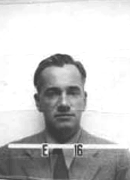
1945 June 26 The United Nations charter is signed by delegates of fifty nations.
1945 June 27 General Leslie Groves meets with J. Robert Oppenheimer and Deak Parsons to plan delivery of atomic bombs to the Pacific theater.

1945 July Final preparations begin at the New Mexico test site, the Jornada del Muerto at the Alamagordo Bombing Range, for the first atomic bomb test, code named Trinity. The date is set for July 16. Jumbo is not used in the test, since plutonium delivery schedules make recovery of active material (in the event of a fizzle) less important.
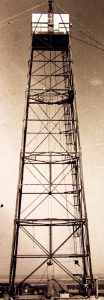
1945 July 3 Casting of the U-235 projectile for Little Boy is completed.
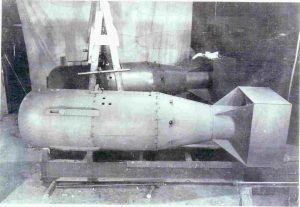
1945 July 6 Machining of the uranium reflector for The Trinity Test completed.
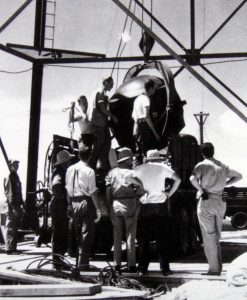
1945 July 7 Explosives lens casting for The Trinity Test completed.
1945 July 10 The best available lens castings are selected for The Trinity Test.
1945 July 11 Assembly of Gadget, the first atomic bomb begins. Also, Japanese Foreign Minister Shigenori Togo cables Ambassador Naotake Sato in Moscow advising him to explore using the USSR as an intermediary in surrender negotiations.
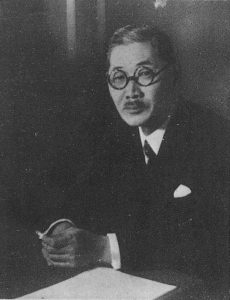
1945 July 12-13 The plutonium core and the Gadget components leave Los Alamos, NM for the test site separately. Assembly of Gadget begins at 1300 hours on July 13. Assembly of Gadget’s explosive lens, uranium reflector, and plutonium core is completed at Ground Zero at 1745 hours.
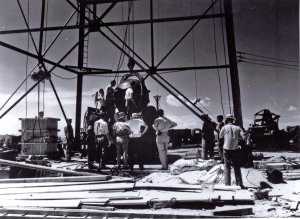
1945 July 14 Gadget is hoisted to the top of the 100 foot test tower, and the detonators are installed and connected. Final test preparations begin. Meanwhile, Little Boy bomb units, accompanied by the U-235 projectile, are shipped out of San Francisco on the USS Indianapolis for Tinian Island. Lastly, the only full-scale test of the implosion lens system (before Gadget) is conducted. Initial analysis indicates failure. Bethe later corrects mistaken calculations and finds that the measurements are consistent with optimum performance.
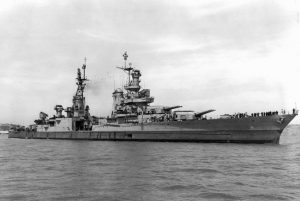
1945 July 16 At 5:29:45 a.m., as part of The Trinity Test, Gadget is detonated in Alamogordo, NM in the first atomic explosion in history. The explosive yield is 20-22 Kt (initially estimated at 18.9 Kt), vaporizing the steel tower.

1945 July 17 Potsdam conference of President Harry Truman, British Prime Minister Winston Churchill (succeeded on July 28 by Clement Attlee), and Soviet Premier Josef Stalin begins.
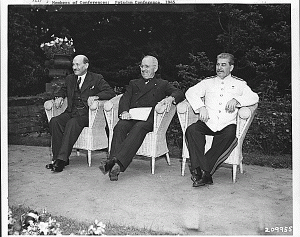
1945 July 19 J. Robert Oppenheimer suggests to General Leslie Groves that the U-235 from Little Boy be reworked into uranium/plutonium composite cores for making more implosion bombs (4 implosion bombs could be made from Little Boy’s pit). Groves rejects the idea since it would delay combat use.

1945 Jul 20 The 509th Composite Group begins flying practice missions over Japan.
1945 July 23 Secretary of War Henry Stimson, in Potsdam for meeting between President Truman and Soviet Premier Stalin, receives current target list. In order of choice it is: Hiroshima, Kokura, and Niigata. He also receives an estimate of atomic bomb availability: Little Boy should be ready for use on Aug. 6, second Fat Man-type by Aug. 24, 3 should be available in September, and more each month – reaching 7 or more in December. Also, first A-bomb test unit dropped by 509th at Tinian, and combat hemispheres for Fat Man are fabricated.

1945 July 24 President Truman discloses the existence of the atomic bomb to Stalin (who had already been informed about it by his spies). Meanwhile, General Leslie Groves drafts the directive authorizing the use of the atomic bombs as soon as bomb availability and weather permit. It lists the following targets in order of priority: Hiroshima, Kokura, Niigata, and Nagasaki. This directive constitutes final authorization for atomic attack, no further orders are issued. Also, The U-235 target for Little Boy is cast at Los Alamos, NM.
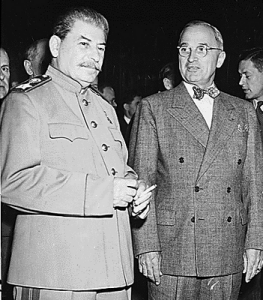
1945 July 25 Peer de Silva, the official courier for the Fat Man core, signs for 6.1 kg of plutonium at Los Alamos, NM.
1945 July 26 President Truman issues the Potsdam Declaration, which warns Japan of “prompt and utter destruction” and requires unconditional surrender of the Japanese armed forces. USS Indianapolis delivers Little Boy bomb units, and the U-235 projectile to Tinian Island. Five C-54 transport planes leave Kirtland Air Force Base, Albuquerque with: the Little Boy U-235 target (its final component); the Fat Man plutonium core, and its initiator.

1945 July 29 The Japanese government rejects the Potsdam surrender demand. Also, the five C-54 transports arrive at Tinian. All components for Little Boy are now on site, but no Fat Man bomb assemblies have yet arrived.

1945 July 30 The nuclear components (target, projectile, and 4 initiators) are inserted into bomb unit number L11.
1945 July 31 The assembly of Little Boy is completed. It is ready for use the next day.
1945 Aug 1 A typhoon approaching Japan prevents launching an attack with Little Boy. Several days are required for weather to clear.
1945 Aug 2 Fat Man bomb cases F-31 and F-32 arrive on Tinian. Fat Man assembly begins. Bombing date is set for August 11.

1945 Aug 4 Lt. Col. Paul Tibbets briefs the 509th Composite Group about the impending attack. He reveals that they will drop immensely powerful bombs, but the nature of the weapons are not revealed.
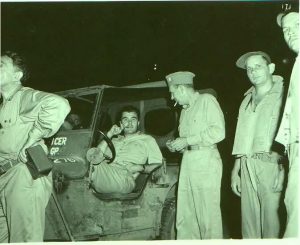
1945 Aug 5 At 1500 Gen. Curtis LeMay officially confirms the mission for the next day. Lt. Col. Paul Tibbets will take over as pilot, Deak Parsons will fly as weaponeer. Lt. Col. Paul Tibbets names B-29 No. 82 the “Enola Gay” after his mother, over the objections of its pilot Robert Lewis. Little Boy is loaded on the plane. Also, Dummy Fat Man unit F33 (complete except for plutonium core) is prepared for practice bombing run.

1945 Aug 6 0000: Final briefing, the target of choice is Hiroshima. Lt. Col. Paul Tibbets is pilot, Robert Lewis is co-pilot. 0245: Enola Gay begins takeoff roll. 0730: The bomb is armed. 0850: Flying at 31,000 ft Enola Gay crosses Shikoku due east of Hiroshima. Bombing conditions are good, the aim point is easily visible, and no opposition is encountered. 0915:17 Little Boy is released at 31060 feet. 0916:02 (8:16:02 Hiroshima time) Little Boy explodes at an altitude of 1850 feet, 550 feet from the aim point, the Aioi Bridge, with a yield of 12.5-18 Kt (best estimate is 15 Kt).
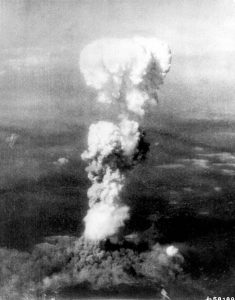
1945 Aug 7 In the absence of an immediate surrender, a crash effort begins to print and distribute millions of leaflets to major Japanese cities warning of future atomic attacks. Also, The date for dropping Fat Man is moved up to August 10, then to August 9, to avoid a projected 5 days of bad weather. This requires skipping many check out procedures during assembly.

1945 Aug 8 At Foreign Minister Togo’s request, Soviet Ambassador Sato tries to persuade the Soviets to mediate surrender negotiations. Soviet Foreign Minister Vyacheslav Molotov cancels the meeting, then announces that the Soviet Union is at war with Japan effective the next day. Meanwhile, leaflet dropping, and warnings to Japan by Radio Saipan begin (Nagasaki does not receive warning leaflets until August 10). Fat Man unit F33 is dropped in practice bomb run. Assembly of Fat Man unit F31 with the plutonium core completed in the early morning. At, 2200, Fat Man is loaded on B-29 “Bock’s Car”.
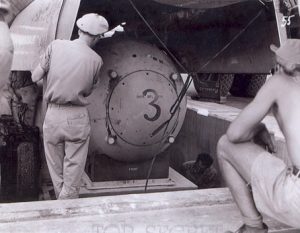
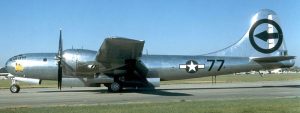
1945 Aug 9 0347: Bock’s Car takes off from Tinian, the target of choice is Kokura Arsenal. Charles Sweeney is pilot. Soon after takeoff he discovers that the fuel system will not pump from the 600 gallon reserve tank. 1044: Bock’s Car arrives at Kokura but finds it covered by haze, the aim point cannot be seen. Flak and fighters appear, forcing the plane to stop searching for it. Sweeney turns toward Nagasaki, the only secondary target in range. Upon arriving at Nagasaki, Bock’s Car has enough fuel for only one pass over the city even with an emergency landing at Okinawa. Nagasaki is covered with clouds, but one gap allows a drop several miles from the intended aim point. 1102 (Nagasaki time): Fat Man explodes at 1950 feet near the perimeter of the city, scoring a direct hit on the Mitsubishi Steel and Arms Works. Yield is 19-23 Kt (best estimate is 21 Kt). Meanwhile, J. Robert Oppenheimer cables General Leslie Groves with the following shipping schedule: 11 Aug. first quality HE unit; 12 Aug. next plutonium core; 14 Aug. another first quality HE unit.

August 10, 1945 Japanese civilian and military leaders are still unable to agree on accepting the Potsdam Declaration’s surrender terms. Emperor Hirohito instead breaks the tradition of imperial non-intervention in government and orders that surrender be accepted, provided that the Emperor be allowed to retain his position. General Groves reports that the second plutonium core would be ready for shipment on August 12 or 13, with a bombing possible on August 17 or 18. President Truman orders a halt to further atomic bombing until further orders are issued.
1945 Aug 11 President Truman and Secretary of State Byrnes reply with an amended form of the Potsdam Decree that acknowledges the Emperor, but still refuses to guarantee his position. General Leslie Groves decides to delay shipping the second plutonium core and contacts Robert Bacher just after he had signed receipt for shipping the core to Tinian Island. The core is retrieved from the car before it leaves Los Alamos, NM. Also, Strategic Air Forces Carl Spaatz halts area firebombing.
1945 Aug 12 Henry DeWolf Smyth publicly releases his report, “Atomic Energy for Military Purposes.”
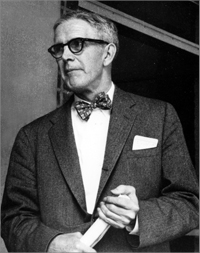
1945 Aug 13 Secretary of War Henry Stimson recommends shipping the second plutonium core to Tinian Island. President Truman orders area firebombing resumed. Gen. Henry Arnold, US Army Air Force, launches the largest raid on Japan of the war with over 1000 B-29s and other aircraft, carrying 6000 tons of bombs.
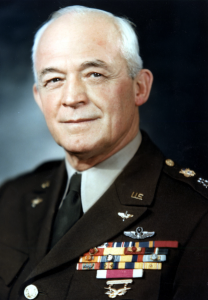
1945 Aug 14 Following leaflet bombing of Tokyo with surrender terms, Hirohito orders that an Imperial Edict accepting surrender be issued. At 2:49 p.m. (1:49 a.m. Washington time), Japanese news agency announces surrender.
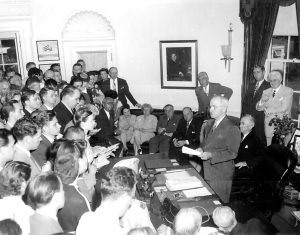
1945 Aug 17 J. Robert Oppenheimer warns Secretary of War Henry Stimson that:Atomic weapons would improve qualitatively and quantitatively over coming years.Adequate defenses against nuclear weapons would not be developed.The US would not retain hegemony over nuclear weapons.Wars could not be prevented even if better nuclear weapons were developed.

1945 Aug 30 General Douglas MacArthur arrives in Japan to oversee the formal surrender ceremony and to establish a democratic Japanese government.
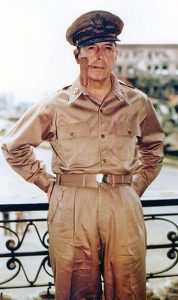
1945 Sept 2 Japanese officials sign the formal Japanese Instrument of Surrender on board the USS Missouri.
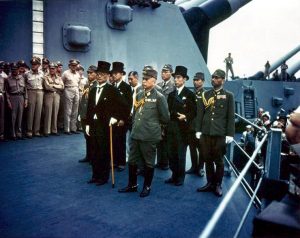
1945 Sept 9 S-50 Plant completely shuts down.

1945 Oct 16 J. Robert Oppenheimer resigns as director of Los Alamos Laboratory, accepting a post at CalTech.
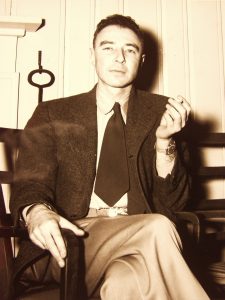
1945 Oct 17 Norris Bradbury takes over as director of Los Alamos Laboratory (a position he would hold for 25 years).

1946 to 1949: Exploring Thermonuclear Weapons
January 24, 1946 The United Nations Atomic Energy Commission is established.
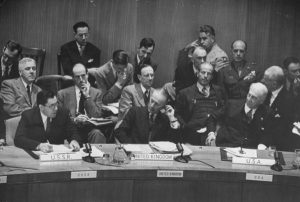
May 21, 1946 Louis Slotin receives a lethal dose of radiation while conducting an experiment placing 2 half-spheres of beryllium around a plutonium core. The screwdriver separating the half-spheres slipped, causing the halves to touch and the plutonium to go supercritical, emitting high levels of radiation.
May 30, 1946 Louis Slotin dies after receiving a lethal dose of radiation from a failed experiment at Los Alamos.
July 1, 1946 The U.S. conducts Shot Able of Operation Crossroads, its first postwar nuclear test, at Bikini Atoll in the Marshall Islands. The purpose of Operation Crossroads, which included two shots, Able and Baker, was to investigate the effect of nuclear weapons on naval warships. The Able test yielded 23 kilotons.

July 25, 1946 The U.S. military conducts Shot Baker of Operation Crossroads, a 23 kiloton standard “Fat Man” stockpile weapon exploded underwater at Bikini Atoll. Operation Crossroads was intended to give information about the effect of the atomic bomb on naval vessels. A column of radioactive water severely contaminated ships that were not otherwise destroyed by the explosion.
August 1, 1946 President Truman signs the Atomic Energy Act. This establishes the Atomic Energy Commission (AEC) which assumes responsibility for all Manhattan Engineering District (MED) properties.

December 25, 1946 The Soviets achieve their first nuclear chain reaction in a graphite lattice that was much like Enrico Fermi’s reactor at the Chicago Met Lab (CP-1).
January 1, 1947 The U.S. Atomic Energy Commission takes over the Manhattan Project’s research and production facilities from the Manhattan Engineer District.
August 25, 1947 The Manhattan Engineering District is abolished.
April 30, 1948 US military conducts shot Yoke of Operation Sandstone, the first fission weapon to use a levitated core design.
August 29, 1949 The Soviet Union explodes its first atomic bomb in Asia near Semipalatinsk. The RDS-1 explosion yields 22 kilotons of TNT, similar to the Little Boy and Fat Man bombs that were dropped on Hiroshima and Nagasaki. The RDS-1 bomb was an implosion weapon containing a solid plutonium core that was modeled after the American Fat Man bomb.
September 23, 1949 Harry Truman announces the explosion of the first Soviet atomic bomb, which came to be known as “Joe-1” (for Joseph Stalin) or First Lightning, to the American public.

October 30, 1949 The General Advisory Committee (GAC) of the Atomic Energy Commission, chaired by J. Robert Oppenheimer, publishes a report on the feasibility of the hydrogen bomb. It recommends that the United States not pursue the development of thermonuclear weapons and instead focus on more advanced fission weapons.
1950 to 1959: The Two Superpowers
January 31, 1950 President Truman announces that the Atomic Energy Commission will “continue its work on all forms of atomic weapons, including the so-called hydrogen or superbomb.”
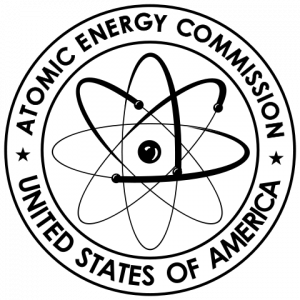
February 3, 1950 Klaus Fuchs is arrested by the United Kingdom for espionage.
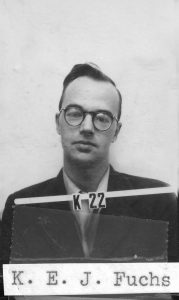
February 24, 1950 The Joint Chiefs of Staff requests President Truman to approve all out development of hydrogen bombs and the means for their production and delivery.
March 10, 1950 After seeking advice from the Special Committee of the NSC, Truman approves the Joint Chiefs of Staff’s request to develop hydrogen bombs. Construction of the reactors for producing tritium thought to be necessary for thermonuclear fuel commenced soon after.
June 9, 1950 Niels Bohr presents his “Open Letter to the United Nations.” As early as 1944, Bohr had recognized that the creation of atomic weapons would completely change the nature of future warfare. Bohr stressed the free exchange of scientific and technological information as critical to creating the basis for peaceful cooperation between nations, and reflected on the “hopes and the dangers” of the Atomic Age.
January 27, 1951 The U.S. conducts its first nuclear detonation, Operation Ranger Shot Able, at the Nevada Test Site.

March 1951 Edward Teller and Stanislaw Ulam come up with a promising design (the details of which are still highly classified) to facilitate the ignition of a large mass of thermonuclear fuel by a relatively small fission explosion. Calculations based on the new design commenced immediately, most of them done by Los Alamos scientists. In addition, scientists used some of the earliest computing machines to help with calculations.
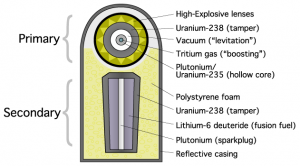
April 20, 1951 The United States Conducts the Shot Easy nuclear test on April 20, 1951 at Enewetak Atoll in the Marshall Islands. It was the second in the Operation Greenhouse series of nuclear weapons tests. The Easy test, meant to test a new, lighter implosion bomb, yielded 47 kilotons.
May 1951 The United States begins Operation Greenhouse, a series of nuclear tests conducted at Eniwetok Atoll to test various design principles that would later become pivotal in the development of thermonuclear weapons. The purpose of these tests was to reduce the size, weight, and amount of fissile material necessary for nuclear weapons, while simultaneously increasing their destructive power.
May 8-9, 1951 The U.S. conducts the “George” nuclear test at Eniwetok Atoll in the Pacific Ocean as part of Operation Greenhouse. The “George” test involved a device in which a relatively large fission yield was to be used to ignite a relatively small mass of thermonuclear fuel. According to Edward Teller, the success of the “George” shot was pivotal in the development of the Super and provided scientists with the confidence to proceed along further speculations of thermonuclear design principles.

October 28, 1951 The United States conducts the Baker Shot; the second nuclear test conducted in the Operation Buster-Jangle test series. It is held at the Nevada Test Site in October-November 1951. Baker is detonated on October 28, 1951, yielding 3.5 kilotons.
October 30, 1951 The US military conducts the Charlie Shot of Operation Buster, a 14 kiloton airdrop fission bomb with a composite plutonium-uranium core.
November 1, 1951 The US military conducts the Dog Shot of Operation Buster, a 21 kiloton airdrop fission bomb with a composite plutonium-uranium core. As part of Operation Desert Rock I, thousands of military personnel were present to simulate activity on a nuclear battlefield.
November 19, 1951 The United States conducts the “Sugar” nuclear test on November 19, 1951 at the Nevada Test Site. The test yields 1.2 kilotons. “Sugar” is the 6th test of Operation Buster-Jangle and is conducted in conjunction with Operation Desert Rock II, with troops conducting maneuvers at a distance of 5 miles to simulate activity on a nuclear battlefield.
December 20, 1951 The first US nuclear reactor to produce electricity, EBR-1, goes critical.
April 1, 1952 The United States conducts the Shot Able nuclear test; the first in the Operation Tumbler Snapper series of nuclear tests at the Nevada Test Site. The test is conducted on April 1, 1952, and had a yield of 1 kiloton.
April 22, 1952 The United States conducts Shot Charlie on April 22, 1952, the third in the Operation Tumbler Snapper series of nuclear tests at the Nevada Test Site. Charlie yielded 31 kilotons, and was part of the Desert Rock IV exercises, where thousands of military personnel trained to simulate activity on a nuclear battlefield.
May 1, 1952 The United States conducts Shot Dog on May 1, 1952, the fourth in the Operation Tumbler Snapper series of nuclear tests at the Nevada Test Site. Dog yielded 19 kilotons. It was part of the Desert Rock IV exercises, where thousands of military personnel trained to simulate activity on a nuclear battlefield.
October 3, 1952 The UK tests its first atomic bomb, known as Hurricane.

November 1, 1952 The United States tests its first ever thermonuclear device at Eniwetok Atoll in the South Pacific during Operation IVY. The Mike Shot yielded 10 megatons of TNT and was roughly 1000 times larger than the bomb dropped on Hiroshima seven years earlier.

November 16, 1952 The United States tests a second nuclear device during Operation IVY known as the “King Shot”. This device was dropped from an aircraft and exploded at an altitude of 1480 feet above its target. The explosion, which derived its energy entirely from fission, was extremely large and probably yielded somewhere around 500 kilotons.

March 17, 1953 The United States conducts the “Annie” nuclear test at the Nevada Test Site on March 17, 1953. It yielded 16 kilotons. A wood-framed house was built for the occasion as part of a civil defense study on the effects of a nuclear explosion.
April 25, 1953 The United States conducts the “Simon” test on April 25, 1953. It was the 7th nuclear detonation in the Operation Upshot-Knothole test series at the Nevada Test Site. It yielded 43 kilotons.
May 19, 1953 The United States conducts the “Harry” test on May 19, 1953. It was the 9th nuclear detonation in the Operation Upshot-Knothole test series at the Nevada Test Site. Shot Harry yielded 32 kilotons, and was the most efficient pure fission device ever detonated with a yield under 100 kt. Due to an unexpected change in the wind, “Harry” caused the highest amount of radioactive fallout of any test in the continental United States, contaminating the city of St. George, Utah. The test was later called “Dirty Harry.”
May 25, 1953 U.S. military conducts Shot Grable of Operation Upshot-Knothole, the first test of a nuclear artillery shell from a 280mm AFAP (Artillery Fired Atomic Projectile). The explosion yielded 15 kilotons and was the second ever US detonation of a gun-type design nuclear weapon.
June 19, 1953 Julius and Ethel Rosenberg are executed by the U.S. for passing atomic secrets to the USSR.
August 8th, 1953 Soviet Premier Georgy Malenkov announces that the United States no longer had a monopoly on the hydrogen bomb.
August 12, 1953 The first test of a Soviet thermonuclear device takes place. The test, which became known as Joe-4 (this had been the fourth Soviet nuclear explosion whose occurrence was announced by the United States), took place at the Semipalatinsk test site and yielded roughly 400 kilotons of TNT.

December 8, 1953 President Eisenhower delivers his “Atoms for Peace” speech which outlines a program for the distribution of peaceful nuclear technology, materials, and know-how to many countries with less advanced research.
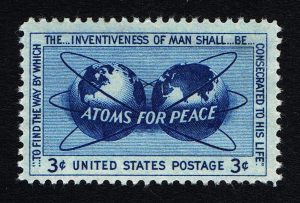
March 1, 1954 The United States conducts the “Bravo” test, the largest thermonuclear device in history up to that point. Bravo was a device using Lithium Deuteride as its fuel and the explosion yielded 15 megatons. The bomb was in a form readily adaptable for delivery by an aircraft and was thus America’s first weaponized hydrogen bomb.
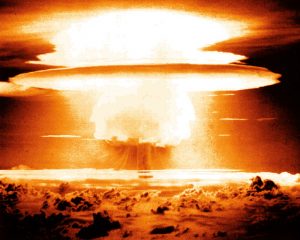
March 27, 1954 The US conducts Shot Romeo of Operation Castle, a 11 megaton thermonuclear weapon whose observed yield was far higher than anticipated (only 4 Mt) due to a lack of understanding of the complex conditions inside of a hydrogen bomb.
June 29, 1954 J. Robert Oppenheimer’s security clearance is revoked by the U.S. Atomic Energy Commission after numerous accusations that he passed atomic secrets to the Soviets.
March 12, 1955 The United States conducts Shot Hornet at the Nevada Test Site on March 12, 1955. It was the fifth of 14 tests in the Operation Teapot nuclear test series. Operation Teapot was designed to test new kinds of fission devices. This test yielded 4 kilotons.
November 22, 1955 The first megaton-range Soviet Hydrogen bomb is detonated in Kazakhstan.
May 28, 1957 U.S. conducts shot Boltzmann of Operation Plumbbob, a light-weight “boosted” nuclear warhead that yielded 12 kilotons. The nuclear system weighed only 145 lbs and was 18 by 32 inches in size.
June 2, 1957 U.S. conducts Shot Franklin of Operation Plumbbob, a 140 ton weapon that was projected to yield 2 kilotons but instead fizzled.
July 5, 1957 U.S. conducts Shot Hood of Operation Plumbbob, a 74 kiloton fission bomb and the largest atmospheric test ever at the Nevada Test Site.

June 24, 1957 The United States conducts Shot Priscilla on June 24, 1957. It was the third of 29 nuclear tests conducted at the Nevada Test Site in 1957 as part of Operation Plumbbob. “Priscilla” yielded 37 kilotons. Operation Plumbbob was the longest, most comprehensive test series in the continental United States and became controversial after much of the operation was declassified. Plumbbob released approximately 58,300 kilocuries of radioiodine (I-131) into the atmosphere over a four month period, producing about 32% of all civilian exposure due to continental nuclear tests.
July 24, 1957 The United States conducts the Shot Kepler nuclear test on July 24, 1957. It was the seventh of 29 nuclear tests conducted at the Nevada Test Site in 1957 as part of Operation Plumbbob. “Kepler” yielded 10 kilotons and was intended to test a ICBM warhead.
September 6, 1957 The United States conducts the Coulomb-B Shot safety test during Operation Plumbbob, a controversial series of 29 nuclear tests held at the Nevada Test Site. Detonated on September 6, 1957, Coulomb-B was intended to make sure that an accidental detonation of conventional high explosives in a nuclear device would not cause a nuclear reaction.
October 4, 1957 USSR launches Sputnik-1, the first artificial satellite in space.
December 6, 1957 The United States conducts the Coulomb-C Shot safety test on December 6, 1957 at the Nevada Test Site. The test yielded an unexpectedly high amount of 500 tons, leading to public concern over nuclear fallout.
June 28, 1958 The “Oak” nuclear test is conducted by the United States on June 28, 1958 at Enewetak Atoll in the Marshall Islands. It was part of the Operation Hardtack I series. The Oak Shot, conducted on a barge, yielded nearly 9 megatons, making it the 6th largest U.S. nuclear test.
August 27, 1958 First shot of Operation Argus creates an artificial radiation belt around the planet.
October 16, 1958 The United States conducts the Shot Dona Ana nuclear test at the Nevada Test Site on October 16, 1958. It was part of the Operation Hardtack II series, in which the United States conducted 37 nuclear tests. It which yielded a relatively small 37 tons.
1960 to 1991: The Nuclear Arms Race
February 13, 1960 France tests its first atomic bomb.
July 20, 1960 The U.S. tests the first submarine-launched ballistic missile (SLBM).
March 14, 1961 A B-52 crashes near Yuba City, California, jettisoning two nuclear weapons.
October 30, 1961 The Soviet Union detonates Tsar Bomba, the largest nuclear device in human history. The weapon yielded 57 megatons of TNT, four times larger than any nuclear device tested by the United States. The amount of explosive energy released by Tsar Bomba amounted to all of the explosives used during World War II multiplied by ten!
May 6, 1962 Shot Frigate Bird is the only US ballistic missile tested with a live nuclear warhead.
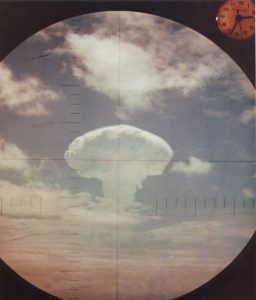
May 8, 1962 US military conducts Shot Yukon of Operation Dominic, a 100 kiloton fission bomb.
July 17, 1962 The US conducts its last atmospheric nuclear test during Operation Storax.
October 16, 1962 The Cuban Missile Crisis begins after surveillance photos taken by a routine U-2 flight over Cuba show Soviet Medium-Range Ballistic Missiles on the island.

October 18, 1962 US military conducts Shot Chama of Operation Dominic, a relatively light weight, small diameter hydrogen bomb meant to fit onto an ICBM. The weapon yielded 1.6 megatons.
June 10, 1963 In his commencement address at American University, President John F. Kennedy announces that “high-level discussions will shortly begin in Moscow looking toward early agreement on a comprehensive test ban treaty.” He declares, “The United States does not propose to conduct nuclear tests in the atmosphere so long as other states do not do so.”
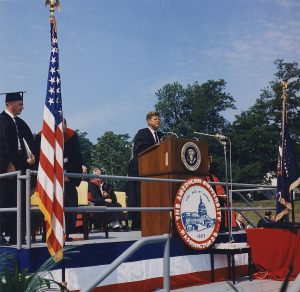
October 10, 1963 The Limited Test Ban Treaty, signed by JFK and Nikita Khrushchev, enters into effect. The LTBT bans all nuclear weapons tests above ground, in the atmosphere, underwater, and in outer space.

October 16, 1964 China tests its first atomic bomb.
January 17, 1966 A B-52 crashes over Palomares, Spain, dropping four hydrogen bombs. Of the four Mk28 type hydrogen bombs the B-52 carried, three were found on land near the small fishing village of Palomares. The non-nuclear explosives in two of the weapons detonated upon impact with the ground, resulting in the contamination of roughly 1 square mile area by plutonium. The fourth, which fell into the Mediterranean Sea, was recovered intact after nearly a 3-month-long search.
June 17, 1967 China tests its first hydrogen bomb. It was a fully functional, three-stage hydrogen bomb, tested just 32 months after China had made its first fission device. China thus produced the shortest fission-to-fusion development known in history.
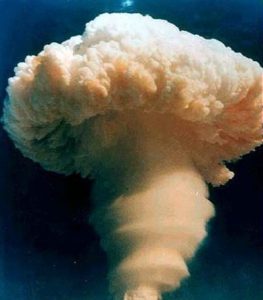
January 21, 1968 A B-52 carrying four hydrogen bombs crashes in Greenland, causing the conventional explosives aboard to detonate and the nuclear payload to rupture and disperse, which resulted in radioactive contamination.
March 12, 1968 The United States conducts the Buggy nuclear test underground at the Nevada Test Site as part of the Operation Crosstie series. Also part of Operation Plowshare, an effort to use nuclear explosives for peaceful construction purposes, Buggy involved the simultaneous detonation of five nuclear devices to excavate a channel. Each yielded 1.1 kilotons.
July 1, 1968 Nuclear Non-Proliferation Treaty is opened for signature. A total of 190 parties have joined the Treaty since 1968, with five states being recognized as nuclear-weapon states: the United States, Russia, the United Kingdom, France, and China (also the five permanent members of the United Nations Security Council).

August 24, 1968 France tests its first hydrogen bomb, code named Canopus, at the Fangataufa atoll. The device was suspended from a large hydrogen filled balloon and produced a 2.6 megaton yield at an altitude of 1800 feet. As a result of the successful detonation, France became the 5th thermonuclear nation.
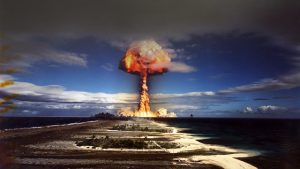
December 8, 1968 The United States conducts the Schooner nuclear test underground at the Nevada Test Site as part of the Operation Bowline series. “Schooner” was also part of Operation Plowshare, an effort to use nuclear explosives for peaceful construction purposes. The test yielded 30 kilotons.
March 5, 1970 The Nuclear Non-Proliferation Treaty signed two years earlier enters into force. The treaty allowed sharing of atomic technology for “peaceful purposes” to non-nuclear nations under the agreement that these nations would never develop an atomic weapons program.
May 26, 1972 US President Richard Nixon and Soviet Premier Leonid Brezhnev sign the Anti-Ballistic Missile Treaty (ABM) and the first Strategic Arms Limitation Treaty (SALT), both of which were important steps in slowing the nuclear arms race between the US and the USSR.

May 18, 1974 India tests its first “peaceful nuclear device” (PNE), dubbed Smiling Buddha. The Smiling Buddha was the first confirmed nuclear test by a nation outside the five permanent members of the United Nations Security Council.

April 7, 1978 Production of “neutron bomb” is cancelled by US President Jimmy Carter. The Neutron bomb is a type of thermonuclear weapon designed specifically to release a large portion of its energy as energetic neutron radiation (fast neutrons) rather than explosive energy. Although their extreme blast and heat effects are not eliminated, it is the enormous radiation released by ERWs that is designed to be a major source of casualties.
March 9, 1979 Temporary injunction granted by US court against The Progressive Magazine for attempting to publish designs for H-bomb. The story contained information about the still-classified “Teller-Ulam” design principle and configuration.
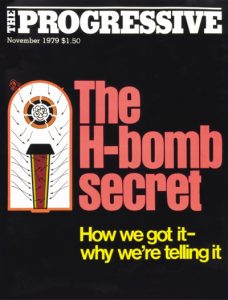
March 28, 1979 A partial nuclear meltdown occurs in one of the two United States Three Mile Island nuclear reactors in Dauphin County, Pennsylvania. The partial meltdown resulted in the release of small amounts of radioactive gases and radioactive iodine into the environment. It was the worst accident in U.S. commercial nuclear power plant history.

September 22, 1979 The US Vela satellite records a “double-flash” characteristic of a nuclear weapons test off the coast of South Africa. The test is believed to be conducted by either South Africa or Israel, however the incident remains a mystery to this day.
March 11, 1983 Pakistan begins sub-critical testing series for nuclear weapons.
September 26, 1983 Soviet Stanislav Petrov, the duty officer at the command center for the Oko nuclear early-warning system, narrowly averts nuclear war when the system reported a missile being launched from the United States. Petrov judged that the report was a false alarm. This decision is credited with having prevented an erroneous retaliatory nuclear attack on the United States, which could have resulted in large-scale nuclear war. Investigation later confirmed that the satellite warning system had malfunctioned.
November 2, 1983 A 10-day NATO training exercise, known as Able Archer 83, begins in Casteau, north of the Belgian city of Mons. The USSR feared that the US would actually launch a preemptive nuclear attack during the exercise.
April 26, 1986 A catastrophic nuclear accident occurs at the Chernobyl Nuclear Power Plant in Ukraine, which was under the direct jurisdiction of the central authorities of the Soviet Union. An explosion and fire released large quantities of radioactive particles into the atmosphere, which spread over much of the western USSR and Europe.
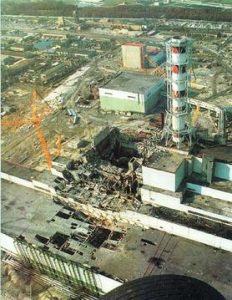
October 5, 1986 The London Sunday Times publishes photos provided by defected Dimona worker Mordechai Vanunu revealing the Israeli nuclear program.
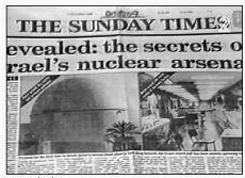
1992 to Present: After the Cold War
September 23, 1992 The U.S. conducted its last nuclear test, code named Divider, at an underground facility in Nevada. It was the last of the 1,032 nuclear tests carried out by the United States since The Trinity Test 47 years earlier.

May 11, 1998 India detonates its first “weaponized” nuclear bombs. It is the first time India has carried out such tests since 1974. The experiments took place without any warning to the international community, and there was widespread outrage and concern over the tests.
May 28, 1998 Pakistan detonates its first nuclear weapons in response to India’s nuclear tests two weeks earlier. The move provoked worldwide condemnation and fears of a nuclear conflict in one of the world’s most volatile regions.
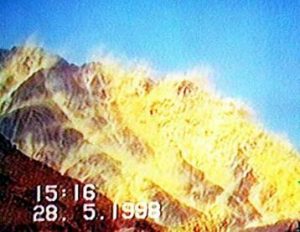
March 11, 2011 Fukushima Daiichi nuclear-power plant accident occurs after a severe earthquake off the coast of Japan.
Timeline courtesy of the Atomic Heritage Foundation, Carey Sublette’s Chronology For The Origin Of Atomic Weapons, and Alex Wellerstein’s Nuclear Testing Calendar.














































































































































_1-207x300.jpg)


.jpg)
_burning_after_the_Japanese_attack_on_Pearl_Harbor_-_NARA_195617_-_Edit-300x237.jpg)














-221x300.gif)










-300x223.jpg)








-207x300.jpg)




















































































